#as well as seeing both leopard AND zebra sharks
Text
𓆝 𓆟 𓆞 𓆝 𓆟
Aquaryum day 🦈🩵🐙
2.24.2023
Aquarium of the Pacific
𓆝 𓆟 𓆞 𓆝 𓆟



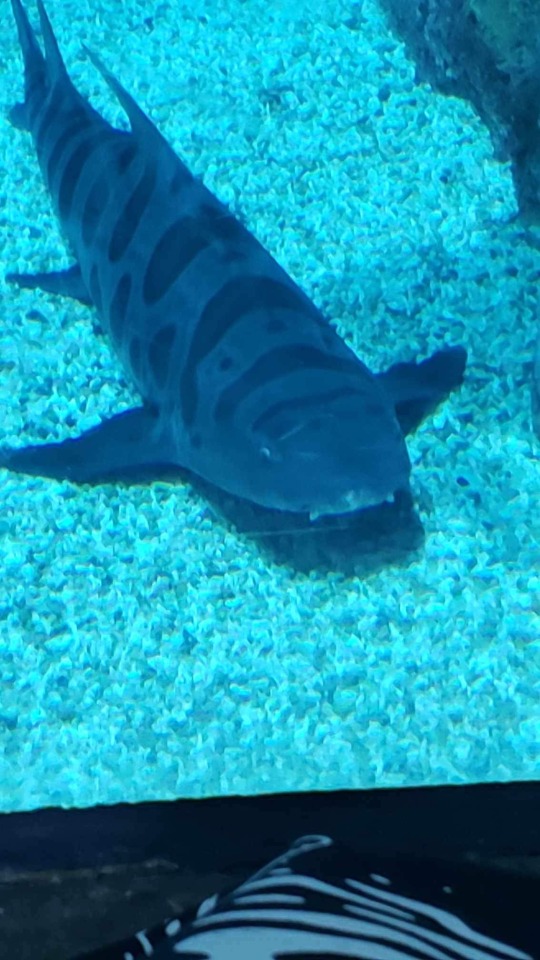
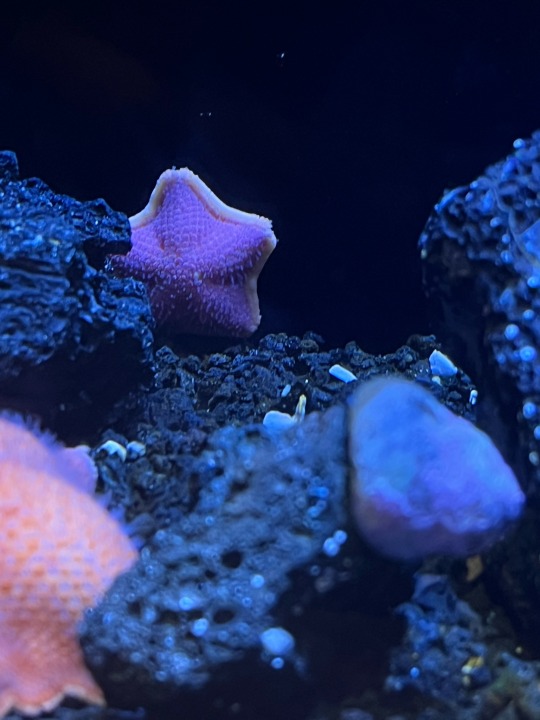


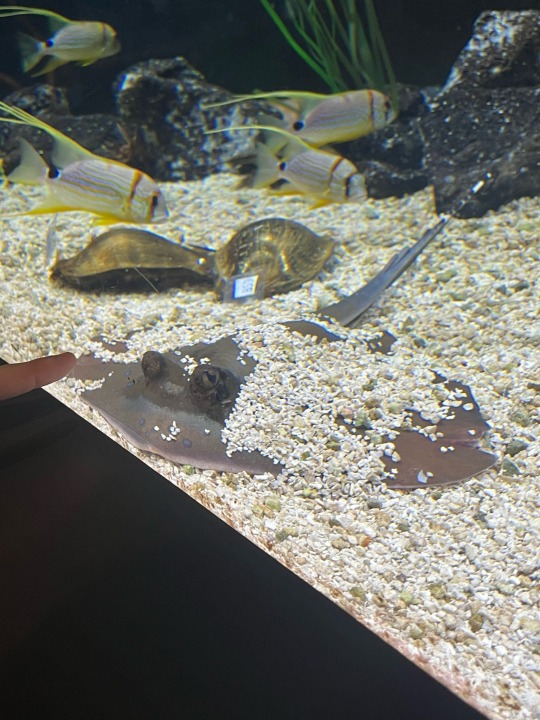
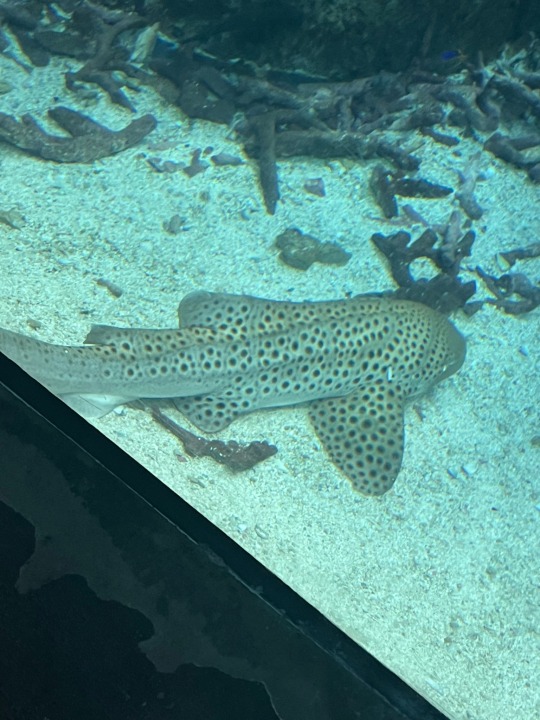

#jay speaketh#my pics#aquarium#sharks spotted I was so happy#got to see bamboo epaulette grey sandbar and blacktip reef sharks#as well as seeing both leopard AND zebra sharks#they confuse me I still need to get their differences down#sharks#fish#ocean#save the ocean#conservation
3 notes
·
View notes
Photo


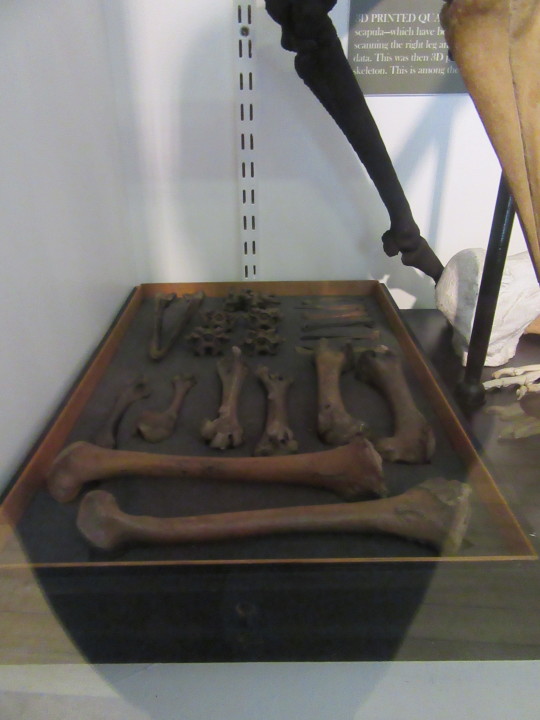



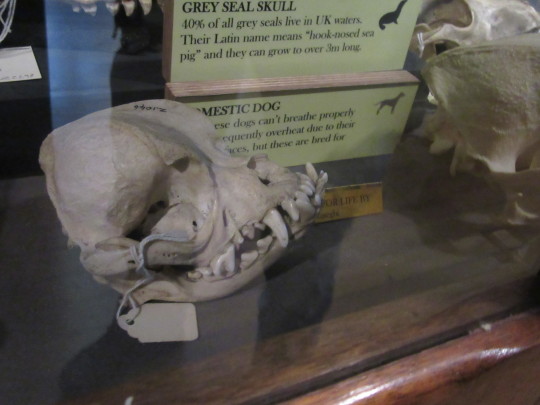


Grant Museum of Zoology, London, England
Also in May (it was a good month) my girlfriend, Jo, visited. We spent two days in Edinburgh, seeing the National Museum, Calton Hill, the university, and the zoo (more on this later), before taking the train south to London for a weekend there.
I have PTSD from being in London in July 2005, and this would be my first trip back as an adult. In January 2019, I had a panic attack just being at Heathrow Airport, so this was a colossal step. As part of easing me into the city, we arrived in the early afternoon, checked into our airbnb, and walked to a museum I had never been to before but was excited about.
The Grant Museum of Zoology is a) free, b) an absolutely packed 1 room of dead animals and c) part of University College London. It is utterly delightful if you are into animal skeletons and taxidermy, and absolutely pointless if you are not; but also it’s free so if you want to drop off the interested members of your party and go do something else, that’s totally viable.
Photos in order:
1. Jar of Moles. Is a jar of moles in formaldehyde. The boring explanation is that before photography, jars of specimens were a good way to get exposed to both species-typical anatomy (aka the features all moles share) and individual variation (ways in which individual moles differ). However something about the caption and the contents makes me giggle hysterically every time.
2. Black-casqued hornbill skull. If you look up the actual animal, you can see that while males have a very impressive head growth, it isn’t nearly as honeycombed as this one. Turns out that that’s because this specimen was over-boiled and the bone structure suffered as a result! Go figure.
3. Dodo bones. The dodo was killed off so quickly after discovery that very few dodo specimens exist; the majority of ‘dodos’ on display are actually mannequins covered in pigeon feathers! So this box of bones is incredibly rare and valuable for study.
4 & 5. Thylacine skull and mount. Thylacine were killed off over a much longer period of time and have correspondingly more surviving material. But the bones are impressive nonetheless. The museum also had a wet specimen (a body in formaldehyde) and various other bits and bobs, but the photos didn’t come out so well.
6. “Isn’t this just a bad horse photo?” you say. No! It is a quagga skeleton, although you can be forgiven for the mistake. Without getting into the fascinating and violent world of zebra taxonomy, the quagga is now regarded as a subspecies of plains zebra with the only variation being in coat color. Stripped to the bones then, a quagga skeleton is identical to a zebra skeleton.
7. Pekingese dog skull. It’s rare enough for any domestic dog skull to be on display, let alone labeled by breed. You can see here the loss of the nasal passages and how the eye sockets have infringed on the brain case--not to mention the problems with dentition!
8. Leopard seal skull, just because it’s horrifying
9. Cookie cutter shark jaws, same reason
2 notes
·
View notes
Text
Kenya's unmissable experiences

Overview
Despite having a coastline of beautiful beaches perfect for lazing. Kenya rarely inspires visitors to sit still – there are simply too many exciting things to experience. Stirring landscapes, ranging from equatorial glaciers and jagged peaks to wildlife-laden. Plains and tropical reefs, provide an epic natural playground for all who venture here, while the many intoxicating cultures surprise at each and every turn.
Big Five safaris
Not only were safaris born in Kenya, but so was the very word itself – it means ‘journey’ in Swahili. Spotting the much-heralded Big Five (lion, leopard, buffalo, rhino and elephant) is a major aspiration of many visitors to Africa, and as one would suspect, Kenya provides some of the continent’s most impressive natural venues for it. None of which is more famous than the Masai Mara, where sightings of all these species is common. Lake Nakuru National Park, with its flamingo-lined lake and forest-clad escarpments, is another incredible place for. Big Five safaris, as is Amboseli National Park, where Mt Kilimanjaro provides a staggering backdrop. Samburu Game Reserve in the remote north is prime safari territory too, and also. Hosts its own ‘Samburu Big Five’: Beisa onyx, Grevy’s zebra, long-necked gerenuk, reticulated giraffe and Somali ostrich.
Lake Nakuru National Park
4-Day Maasai Mara Game-Lake Nakuru Park Safari
2 Day – Lake Nakuru & Naivasha
Hiking
Mt Kenya’s trekking terrain is arguably the continent’s most beautiful and rewarding. Its diverse valleys, equatorial glaciers and dramatic, towering summit are extraordinary sights, and best seen over a challenging multi-day hike to. Point Lenana (4985m), the mountain’s third-highest peak (and highest reachable without climbing equipment). The more gentle slopes of Mt Elgon, which are home to elephants, primates, antelopes and some 240 species of birds, are another great option for treks lasting several days, as are captivating walks with the Maasai through their homelands. Incredible day hikes are also possible throughout the country: climb up Mt Longonot to its crater rim; seek out remote waterfalls in the mountains of Aberdare National Park; or take a more leisurely stroll within the dense Kagamega Forest while listening to birdsong.
4-Day Lake Naivasha-Lake Nakuru/Maasai Mara Game Reserve
The Great Migration
It’s been called the greatest natural spectacle on the planet, and for good reason – each year from July to October,.Hundreds of thousands of wildebeest and zebra make a dramatic crossing of the crocodile-infested Mara River to feed on the lush grasses of the Masai Mara. The flood of animals filling the open savannah includes herds of elephants and giraffes, and trailing this sea of prey are lions, leopards, cheetahs and hyenas. Needless to say, there is never a shortage of drama during the great migration.
Mountain biking
Mountain biking is not just mountain biking in Kenya – here this two-wheeled pursuit offers. A unique means of embracing both the country’s incredible landscapes and its iconic wildlife. Ride over the red earth paths in the volcanic confines of Hell’s Gate National Park, cycling past grazing buffaloes, giraffes. Impalas and zebras, or take to the grasslands of the Masai Mara for a cycle safari like no other – the sense of engagement with the wildlife is amplified to no end when in the saddle. Of course, for the purest mountain bikers who want nothing more than to test their skills, there are some great single track routes of varying gradient and difficulty on Mt Kenya and within the Rift Valley above Naivasha. For those wanting a more leisurely cycle, exploring the coastal areas around Diani Beach, Malindi and Watamu by bike is an engaging option too.
Cultural encounters
Although it is dreams of Kenya’s wondrous wildlife that draws most people to this East African nation. Many people’s lasting memories revolve around their interactions with Kenyans themselves. The Maasai people, with their traditional red shukas, brilliant smiles and overwhelming presence, add a depth of warmth to any trip into the Mara region.
The same can be said for the striking Turkana people in Loyangalani along the eastern shore of the Jade Sea (Lake Turkana). Visitors to the Marsabit-Lake Turkana Festival in early. May also meet many of the other enigmatic and colourful tribes from the Kenya’s remote north, such as the El Molo, Rendille, Samburu, Dassanatch, Gabra, Borana, Konso, Sakuye, Garee, Waata, Burji and Somali. The diversity of cultures in Kenya is truly astounding. While the Swahili people on the coast differ in that they don’t share a common heritage. They are bound by a language and an African history that is tied to Arabia and Persia – there is no better place to immerse yourself in this world than in the labyrinth of crooked alleyways in Lamu.
Dhow trips
Kenya’s Indian Ocean coast is beautiful no matter how you look at it. But there is no more romantic way to experience it than from the deck of a traditional dhow. These wooden sailing vessels have been used along this stretch of coastline for centuries, and they are still entrenched in the Swahili culture today. Whether launching from the historical island of. Lamu (home to Kenya’s oldest continually inhabited town) or the modern resort village of Diani Beach, these wind-powered voyages will slip past stunning slivers of sand. Remote coral islands and reefs teeming with fish.
Water sports
Want a burst of adrenaline with your taste of the Indian Ocean? The same winds that power the elegant dhows fuels two great water sports: windsurfing and kitesurfing (also known as kiteboarding). The latter has caught on massively in Kenya, with many schools now providing lessons for beginners as well as equipment rentals for people with experience. Diani Beach is the epicentre of action, though the waters off Watamu are also highly recommended. The fun doesn’t stop inland, however, with whitewater rafting trips possible on both the Tana and Athi rivers, which thunder down from the Central Highlands at certain points during the year.
Hot air ballooning
Perhaps the most intoxicating safari experience in Kenya is to slowly climb. One exciting flame blast at a time – above the famous rolling savannah and flat-topped acacia trees of the Masai Mara in a hot air balloon. Floating silently over streams of wildebeest on their great migration. Lions stalking their prey or a lone black rhino moving through the bush is a perspective that nobody can ever forget. When the light is just right it’s possible to marvel at the perfectly proportioned. Elephant-shaped shadows cast by the largest member of the Big Five. Few experiences in life are as peaceful as they are exciting, and a balloon safari here is certainly one of them.
3 Day – Amboseli Wildlife Safari
Diving and snorkelling
With much of the coast sheltered by reefs, Kenya’s calm inshore waters – speckled with shoals of vibrantly coloured fish. Provide some of the easiest and most transfixing snorkelling in East Africa. Simply float above the seabed five metres below and take it all in. Or strap on a tank and take a deeper dip on the other side of the reef, where whale sharks, dolphins and swordfish play. For those wanting to up their diving skills there are some highly regarded operations that offer open water diving courses. For beginners, Kenya is also a great place to get your toes wet – there are schools in Diani Beach. Malindi and Wasini Island that teach .PADI (Professional Association of Diving Instructors) courses, which start in shore-based pools beneath swaying palms.
Camel safaris
These unique safaris are a wonderful way of mixing wildlife, culture, landscapes and adventure by getting into remote areas. Where few others (and often no vehicles) go. Most operate in the northern tribal areas of the Samburu and Turkana. Which means visitors will also witness nomadic life and mingle with local people. Wildlife is not as prolific as in the southern parks, but on these trips it does not matter – the journey is the main attraction. Mornings are spent on the move, with visitors either riding the camels or walking alongside them (whichever they prefer). After striking camp around noon, participants have the rest of the day to enjoy guided walks and cultural interactions or to just relax. Experienced Samburu moran (warriors) usually lead the caravans. With English-speaking tribal guides on hand to dispense interesting details on local folklore, botany, ornithology and local customs.
See also:Amboseli National Park Destination Guide, Wildebeest Migration Masai Mara, Masai mara National Reserve and Conservancies, The Top Safaris in KenyaTop Weekend Getaway Deals in Kenya
If you think you have to travel far to enjoy a nice weekend, you may never get away. Besides, you can enjoy a beautiful weekend right here in Kenya. There are countless wallet-friendly Kenyan weekend getaways that won’t even break your budget. Don’t spend your weekend, doing absolutely nothing at home. Whether you are looking for romantic destinations, pristine beaches, and adventurous outdoor activities, there are plenty wallet-friendly getaways that will satisfy your weekend desires.
Mombasa South Coast Self Drive Deals
Lake Nakuru & Elementaita Self Drive Deals
Lukenya & Machakos Self Drive
Amboseli and Tsavo Holiday Self Drive Deals
Mt. Kenya & Aberdare Self Drive Holiday Deals
Mombasa North Coast Self Drive Deals
Samburu Holiday Self Drive Deals
Masai Mara Self Drive Holiday Packages
Malindi & Watamu Self Drive Deals
Nyahururu & Laikipia Holiday Self Drive Deals
Top Madaraka Express SGR Holiday Deals
2 Nights Malindi & Watamu holiday with SGR
2 Nights Amboseli Holiday With SGR
2 Nights Tsavo Holiday With SGR Sa
2 Nights Voi Holiday With SGR
2 Nights Mombasa North Coast With SGR
2 Nights Mombasa South Coast With SGR
Read the full article
0 notes
Text
Summer Vacation 2019, Omaha, Denver & Beaver Creek/Vail, 7/7/19 – 7/14/19
By: Daddy, Ashlynn, Brianna, Scarlett & Felicity
As we sat in the hottub on our final night in the gorgeous mountain resort, we asked the kids, what’s your favorite vacation we’ve taken as a family? Runner up answers included Yellowstone, Disney and Chicago. But overwhelmingly, the consensus #1 family vacation the Blaniels have taken is the vacation we were currently on! Yep, Dyan and I struck vacation gold again! Here’s how we got to that consensus!
7/7/19
We were on the road by 6AM. We weren’t traveling in an airplane, train, RV, transit van, or even Dyan’s SUV. Nope, we rented a minivan for this excursion. We picked up the van a day earlier so that Dyan and I could get everything loaded up the day before. That made our morning departure so much easier – and less stressful!

Day one was a nice little drive down through Des Moines and over to Omaha. We arrived at lunch time and quickly made our way into Omaha’s Henry Doorly Zoo. We did a summer vacation here four years ago, and it was absolutely, hands down the coolest zoo we’ve ever been to.
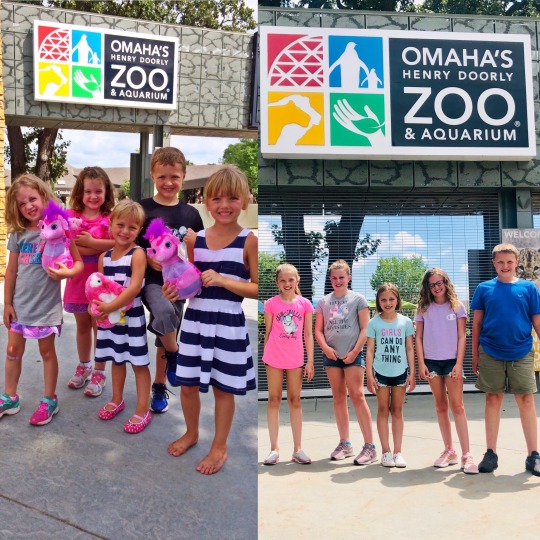
So, when we told the kids this was our first stop on the summer roadtrip, they were super excited.
We explored the east side of the zoo, making sure we hit the Lied Jungle, Wild Kingdom Pavilion and Scott Aquarium.
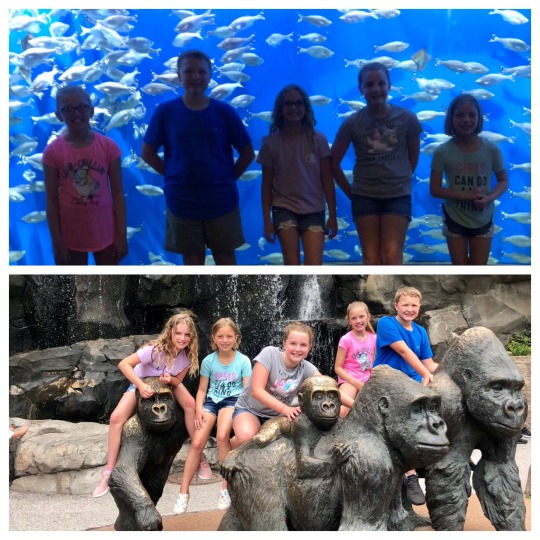
Afterward, we made our way over the Hubbard Gorilla Valley, Orangutan Forest and the tiger and leopard habitat.
But the exhibit all the kids wanted to see was the African Safari area where you can view it from the air on the “Skyfari” Chairlift.

The rhinos, giraffes, zebras and lions were all in sight as we sailed across the park on the skyfari. The kids favorite animals were:
Ashlynn: Deerbra - half deer, half zebra
Brianna: Sharks
Scarlett: Fennec Fox
Felicity: Aligators
Aidan: Gorilla
All Kids: Baby Orangatan
Prior to leaving, take one guess what we ended up doing? GIFT SHOP! The kids wandered the gift shop picking up every stuffed animal in the store. Everybody wanted a stuffed animal, but nobody wanted to spend their own money. So, Dyan and I did what we always do which is let the kids save their money, and we bought everybody new furry friends!!
By late afternoon, the temps were sweltering. The kids needed some aquatic relief, so we headed back to the hotel and swam in the pool while deciding on dinner. Dyan and I were trying to find a fun pizza joint when the kids unanimously voted (while in the pool) on Pot Belly and Cold Stone Creamery. Both locations were less than a mile from our hotel. Kids for the win.

Later that evening, we all went swimming again, complete with a very intense game of Marco Polo.
7/8/19
The second consecutive morning, we were on the road by 6AM. Denver-BOUND! Outside of Omaha, Nebraska doesn’t have much to offer in terms of sightseeing, entertainment or roadside stops. So, the kids did blew through their iPad batteries in record time as Dyan did her best to keep the kids screens charged with the two chargers we brought. It was a carousel of iPhones and iPads rotating throughout the van.
We rolled into Denver shortly after 1PM. Made a quick lunch stop at Chipotle before taking the kids out to Red Rocks. There was scattered thundershowers in the area, but we timed it just right to miss most of the rain.

The kids played around in the amphitheater area and posed for pictures in the rock formations just outside of the concert venue.

The kids were adamant that they wanted to return here if Taylor Swift ever played a show at Red Rocks!
We then made the quick trip over to Golden, CO, to get checked into our hotel. The kids swam in the pool for about 20 minutes before a big storm blew up on us and forced us back to the room. No big deal! We needed to get ready for dinner anyway. After the rain had passed, we walked around the town of Golden checking out the gift shops and grabbing dinner at Woody’s. Woody’s is a great little restaurant Dyan and I discovered on our trip here in 2014. Delightful pizzas, and ice cold beer.

Dyan and Jake for the win! Of course, we followed up dinner with ice cream from Golden Sweets.
7/9/19
This was the big day. The day we’d finally reach our main destination for the summer vacation – VAIL, CO! After a quick breakfast at the hotel, we were back on the highway, heading into the mountains. The drive from Denver into the mountains never gets old. Full of mountainous scenery and old mining towns, the interstate whisks you up, up and away into the snow capped Rocky Mountains. About 45 minutes into the trip, we hit the Eisenhower Tunnel at Loveland Pass. Once through the tunnel, we began the long steep downgrade into the Summit County Valley. About 1/3rd of the way down the pass, the van started to vibrate a bit as I applied the brakes on the steep slope. Not thinking anything of it, I continued to brake to keep my speed in check. About half way down the pass , the van started shaking when I applied the brakes. Something wasn’t right – but I wasn’t sure what was going on. We continued. We passed a sign that said something like, be cautious, you aren’t to the bottom yet. At that exact moment, an overwhelming burning smell filled the cabin of the van. I looked at Dyan. We were both confused. I braked hard and the van shook almost violently as I pulled her over on the shoulder. The brakes were burning up. Apparently, I had been applying them a bit too much, a bit too often. Oops. We sat on the shoulder, Dyan and I questioning, “What do we do?”. Although neither of us said it, I know we were both imaging the worst case scenario where the van’s brakes went out leaving us with escalating speeds as we broke loose down the mountain desperately looking for one of those “Runaway Truck” ramps. Thank God it didn’t come to that…
After about 5 minutes, the smell began to subside and we got back on the road. The remainder of the drive through the mountains we much more uneventful now that I was aware of the touchy brakes in the minivan. We entered into the Vail Valley around 9AM. Vail Mountain is enormous as it towers over I-70. It certainly looked like it would be one heck of an adventure during the ski season. About 10 minutes past Vail is the town of Avon, which is at the base of Beaver Creek Ski Area – also a quaint resort tucked back in the mountains. Sticking out high above the trees was our massive European-chalet-style resort, the Westin Riverfront at Beaver Creek. The resort facility on it’s own would be spectacular, however, when you add in the setting of the snow capped mountains in all directions around it, the property is remarkably breathtaking. How are we so lucky to be able to stay in a place fit for a king?

We couldn’t check into the property yet, so we headed into the gated mountain village of Beaver Creek, a short 2 mile drive up into the mountains.
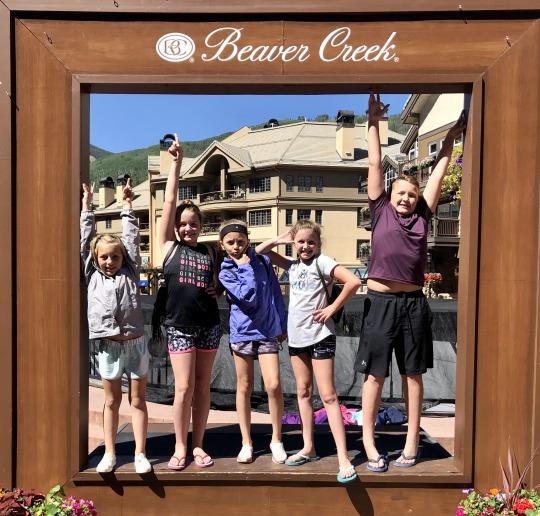
We browsed the gift shops and got a delicious fresh berry crepe at Rimini for us all to share – it didn’t last long. But at $14/crepe, this was not going to be our lunch spot!

Back at the resort, the valet attendant recommended the Avon Bakery & Deli for lunch. It was only a couple blocks away, so we could walk. When we stepped inside the restaurant we could immediately tell this was no regular Subway or Potbelly. Nope, it was ALL ORGANIC with bread straight out of the wheat field. It was the kind of place that frowns on Pepsi and Coca Cola products – instead they produce their own small batch craft colas (complete with paper straws). It’s definitely where the hippy, green, liberal, vegan, organic crowds congregate to “organize” and drink specialty coffee that is procured through community co-ops. And it was pretty chaotic. There was a long counter, like at a fast food joint. Behind the counter, there must have been a dozen people “working,” but really only 2 were actually doing anything. The rest appeared to be sluggishly coming down from their pot high from the night before – afterall, the weed is legal in Colorado! In front of the counter was a very small lobby, that was packed with loiterers who appeared to have skipped 1st grade when they learned the social skill called “line formation”. There were people standing everywhere in the small lobby, some waiting on food, others wondering whether it was their turn to order, a few waiting for tables and many snaking their way through the crowd to the pop refill station. Well, we entered like a tornado. Picture five hungry kids on the brink of hunger meltdowns amongst pretentious tree-huggers that probably don’t care for kids to begin with. Priceless.
And speaking of priceless, the menu was priceless too. We ordered 3 sandwich meals and 4 kids meals (flat meat hoagie w/ chips and a pop). The bill was $130. WHAT!?! Kid meals turned out to be $14 and adults were $20. For lunch meat! Should have stayed at the Crepe stand!
After lunch, we rendezvoused back at the Westin and spent a couple hours enjoying the pool and hot tub.
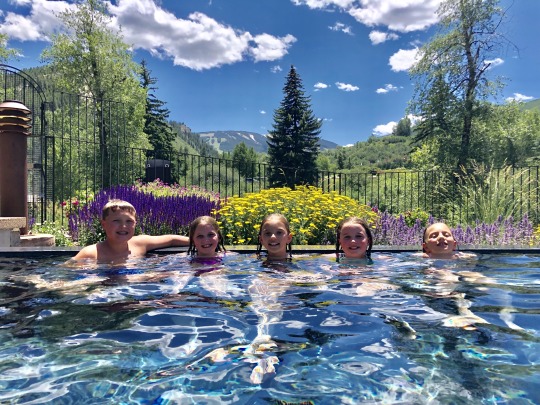
Our big event of the day was whitewater rafting on the Lower Eagle River. Late in the afternoon, we arrived at our river outfitter, Lakota Guides, where they quickly sized us for splash jackets, neoprene boots and helmets.
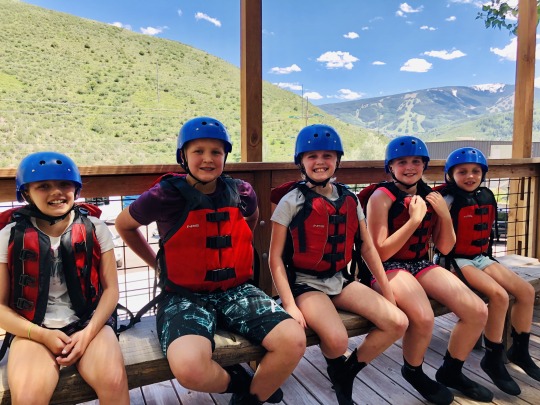
We had about a 20 minute bus ride down river to the Wolcott BLM Campground. Our group of about 40 people were divided up into 5 rafts. The Blaniels got their own raft!
The sunshine was sweltering, but the water temps were paralyzing. When we booked this excursion in February, Lakota Guides indicated this river began taming in early July, and by mid-late July would have so little water that rafting closes. The average water flow on the river is about 250cfs (cubic feet/second). In a typical spring/summer, we’d be hitting the tail end of the snow meltoff, which should run closer to 1,000cfs. But…..this winter/spring was a rarity in terms of how much snow Colorado Rockies got. With data going back to 1882, Colorado had 60% more snow this winter than an average season. In the middle of July, the peaks of the surrounding mountains were all snowcapped. And due to the extreme heat over the past couple of weeks, the snow melt had intensified. The waters were roaring down the mountains and flooding the normally trickling creeks and rivers. The current was running about 3,500cfs. The river was so ferocious, Lakota Guides called us a week earlier to inform us the minimum age requirement for our float was being increased from 6 years old to 9 years old. Whew, Brianna would barely squeak by with 3 months to spare!
We boarded the raft with our guide, Byron. Byron guided for many years on the Colorado River but has been retired from guiding for a couple years. However, when the Lower Eagle River flooded in the past few weeks, and the rapids gained national attention due to the extreme runoff, he jumped out of retirement for the chance to guide on this intense stretch of river.
The first 10 minutes of the float were relatively benign – a good stretch to get acclimated to the raft and paddle. The water was ice cold as it was the product of melted mountian snowpack a mere 12 hours earlier. Byron encouraged some playful splashing. Brrr.
As we proceeded down river, the rapids got more intense. Not sure it was the vertical drop in the stream as much as how long the rapids were strewn out. We were ripping from one rapid to the next with no real break in between. It was awesome. Unfortunately for me, I seemed to endure the brunt of the rapids. Sitting opposite of the guide, the front right corner of the raft seemed to meet every rapid head on, soaking me in the icy water.
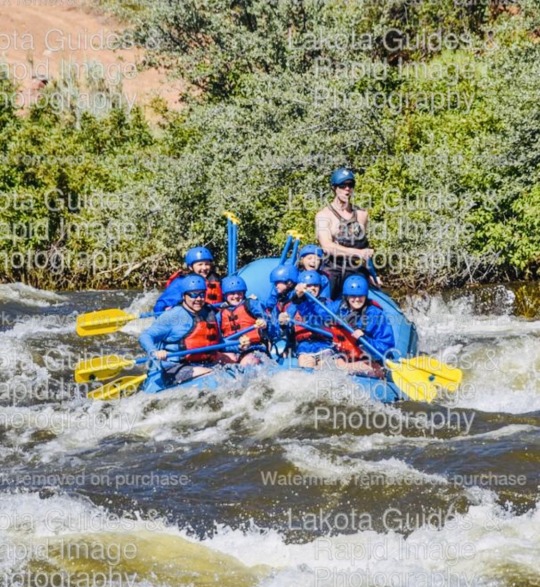
For the second straight year/vacation, the kids did as little as possible to actually help get the raft in position to take on the waves. Instead of paddling, they were screeching with enjoyment as they splashed each other and rode bull on the front of the raft. We had struck vacation gold.
As if the day couldn’t get any better, later in the evening we drove back up to Beaver Creek where they were showing a movie under the stars at the base of the ski hill. We spread out blankets and brought snacks.

By the end of the movie, we had all retreated to the fire pit viewing area as the chilly mountain temperatures set in.
7/10/19
This was our most adventurous day of the trip as we were spending the entire day using out Mountain Adventure passes at the summit of Vail Mountain. The adventure passes were pretty sweet, and certainly a vacation highlight for all of us.

The excursion started with a 10 minute gondola ride to the to Eagle’s Nest. The summit was covered with outdoor family activities.
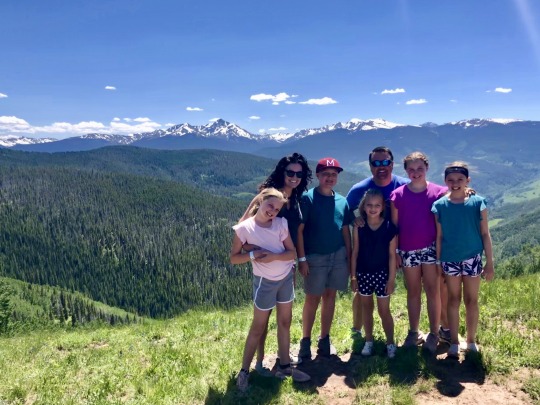
First up, the Forest Flyer Mountain Coaster. Its like bobsledding on rails. The ride lasts about a minute, but sends you flying down the mountain at speeds over 40mph. The vertical drop of the coaster is 3,400 feet. That is a bigger drop than nine Welch Village ski runs (360 ft.) stacked on top of each other! This would proves to be such a family favorite, we came back to ride a second time later in the afternoon.

Next up was the Bungee Trampoline, which also was a favorite, and experienced twice during our stay. Who knew doing flips on these was so difficult!
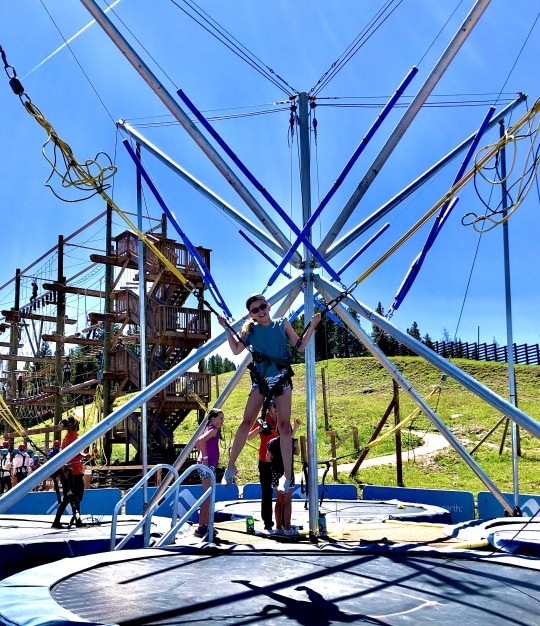
The third activity of the day was the ropes course. Aidan and Ashlynn braved the Gore Range Adventure Course scaling and crossing obstacles suspended by cable more than 30 feet in the air.

By this point, the kids started to split up, as not everybody wanted to do the same activities.

Brianna and Felicity did the Game Creek Zip Lining Tour before joining Scarlett at the Paramount Peak Climbing Wall.

Then they all did Eagle’s Nest Tubing and the Marmot Mini Kids Tubing.

Even though the kids tubing was for a younger crowed, our kids loved getting sprayed with water on the hot summer afternoon. For how hot it was, we were surprised to see see piles of (dirty) snow on the ski hill.
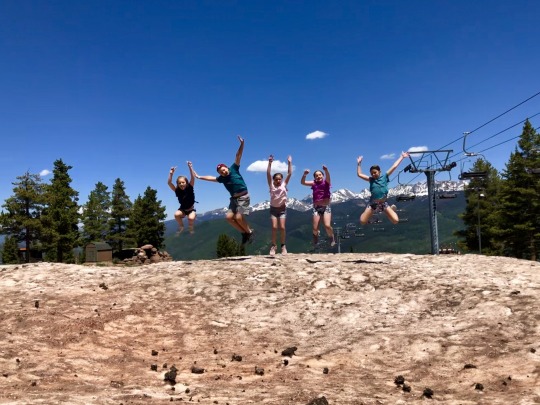
Before doing some second and third passes on the adventure course, we had a great sit down lunch at Eagle’s Nest Restaurant. And by 4PM, we were exhausted. The sun and altitude were getting to everybody. We needed to cool down and get back down the mountain.

Once in Vail Village, we found Haagen-Dazs Ice Cream, and a fountain in the middle of the village.

Later that evening, Dyan got the girls all dolled up and we went out for pizza.
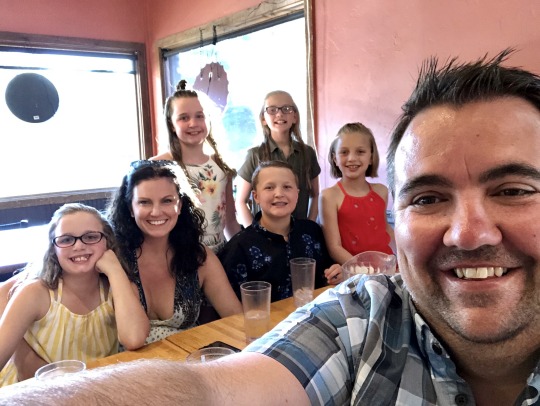
Since it was such a beautiful evening, we got some great pics of the kids around the resort.
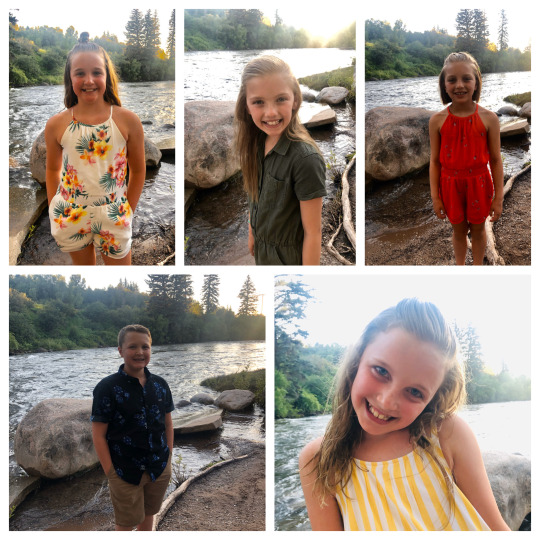

7/11/19
Pool Day! We were at the pool by 10AM, staking claim to front row at the pool – a very highly coveted location. While the kids frolicked in the pool, Dyan and I picked up Starbucks and a grab bag of candy for them. They literally played in the pool, ALL. DAY. LONG.

That night, we went to the Beaver Creek Rodeo, which was a lot of fun for the kids.

There was candy, face painting, pony rides and even a calf chase (for prizes) where the kids got to go out into the rodeo.
But the unexpected highlight of the night was an evening dip in the pool. As dusk settled in, storm were springing all around us, but our resort seemed to dodge most of them. We all sat in the hot tub and reminisced about our favorite and least favorite vacations. When we asked the kids what their least favorite family vacation had been, Ashlynn put it best when she said, “I wouldn’t call any of our vacations bad, it’s just that some, (Disney) are better than others.” All the kids agreed, this vacation IS the BEST. Dyan and I tended to agree. Being at a 5-star resort with the kids is a dream come true, and best of all, the kids are finally at an age where they can begin to appreciate the significance of this kind of vacation.

Out of nowhere, the clouds opened up and began downpouring on us. What would have been the end of the night for most families turned into just the beginning for us. The kids shrieked as the cold raindrops poured down on them. But we had no plans to let this “rain on our parade.” We played right though the thunderstorm. We swam in the pool for 3 hours that evening, until it closed at 11PM. There was a flag banner than stretched across the pool. We spent well over an hour taking running jumps into the pool, trying to touch the flags. It was an absolute riot. It was my favorite night of the vacation. Sadly, it was also, our last night at Beaver Creek…
7/12/19
…But our vacation was not over. Nope, not in the least, we had a few more things to do and see. Our morning started off with a huge, delicious, breakfast at Northside Kitchen.

Next stop, Keystone, CO. This is the ski area Aaron and I skied at in March. We arrived a couple hours early, so we spent some time shopping around the ski village and feeding the gigantic rainbow trout in Keystone Lake.

Our big adventure of the day was horseback riding through the Arapaho National Forest. After arriving at Keystone Stables, we all got assigned horses:
Ashlynn: Angus

Brianna: Peanut

Scarlett: Scout

Felicity: Rio

Aidan: Teddy

Dyan: Rocky
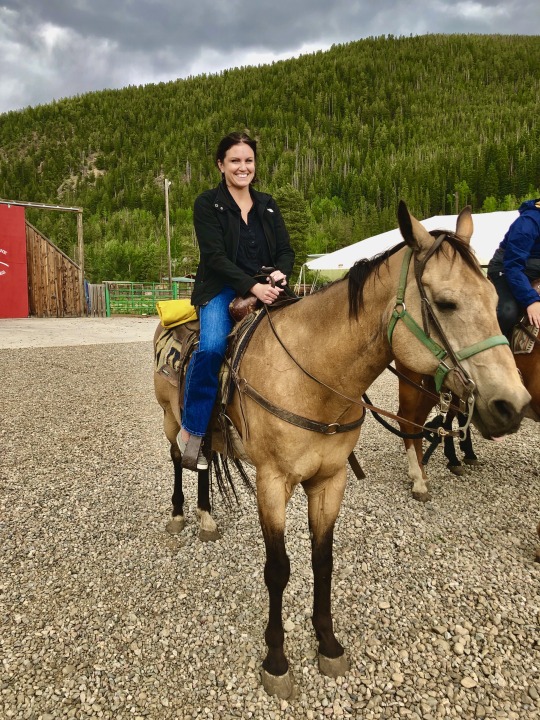
Me: Hack

We bought a 90 minute trail ride through the national forest. I’ve been on a few trail rides in my days and they’ve run the gamut of good to bad. Some are just walks along a dirt path which can get pretty monotonous. Keystone Stables had a different kind of ride in mind for us. One that would test our abilities of riding horse while climbing the side of a mountain in one of the most picturesque national forests in the country. To say it was anything less than phenomenal would be straight up inaccurate.

The ride started with a gentle stroll through the pasture toward the base of the mountain. This would be the only chance we’d have to get acclimated to the horse. We quickly ventured into thick forest and steep, uphill terrain. At times, the trails were so narrow, our horses had us brushing up on trees and rock ledges. We climbed over 2,000 feet up the side of the mountain as we moseyed along switchbacks and across avalanche slide areas. And for some reason, Dyan and I got the problem ponies. It seemed as though Rocky hadn’t gotten enough lunch. He kept stopping to eat the grass, which was a “No-No” in the national forest. No amount of pulling the reins was going to stop his afternoon snack. And Hack also had an issue. He’d act like a pokey puppy creating 20-30 yards between us and Dyan/Rocky before going into a full blown trot, almost gallop in an effort to catch up. Our guide noticed this one occasion and asked me to keep our speed in check. Oopsie.

The ride down the mountain was probably more fun than the ride up had been, because we had to do a lot of leaning back to help keep the horses speed and balance in check as they ventured down the steep terrain. The kids absolutely loved the trail ride and grew quite fond of their equestrian companions. After we got home from the trip, we asked the kids what their favorite excursion was on the trip. Trail ride. Unanimous. Vacation Gold!
We made the hour drive back to Denver, with a picturesque stop at Loveland Pass.

But before the night was complete, we had another special treat for the kids. Dinner. But not just any dinner.

Our reservations were right at 6PM. Our venue was the iconic, Buckhorn Exchange! The kids went crazy over all the stuffed animals in the place. We played a cutthroat game of “I Spy” pointing out the most obscure and unique animals in the restaurant.
When it was time to order, the kids went with some unique plates too. For starters, we all shared the cheesy rattlesnake dip, which was an absolute hit. EVERYBODY tried it!

For dinners, Aidan got a Buffalo ribeye and Scarlett they Buffalo cheeseburger. Ashlynn and Brianna ordered ribs while Felicity wanted chicken fingers. Dyan and I split the filet and quail dinner. Everybody enjoyed their meals, however, the quail was nothing to write home about.
After dinner, we spent the evening at the downtown Sheraton hotel, rooftop pool.

7/13/19
The morning started off with a 1st breakfast at the Sheraton Club Lounge. We met the manager in the lounge, and he was quite impressed with the kids behavior among the group of business travelers enjoying a quite breakfast. He called down to the main hotel kitchen and had them prepare some giant, fresh, warm, gooey, chocolate chip cookies! They were absolutely delightful. After checking out of the hotel, the kids had their 2nd breakfast at Krispy Kreme, right next door. The sugar would be running high today.
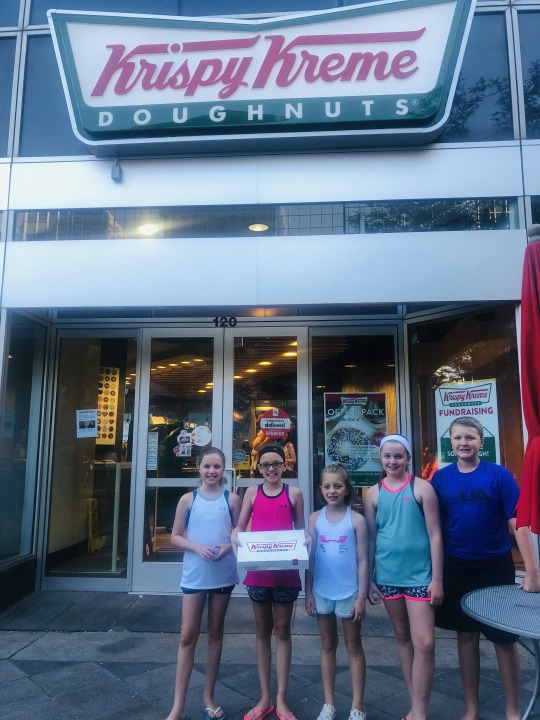
The drive to Omaha should have been super long, and boring, but we came up with a new game. As the kids played on iPads, Dyan and I started a competition. The good ‘ol A-Z game. Simple rules, find a license plate or word that begins with A before progressing to B, then C, and so forth. The game got feisty as Dyan pulled way out ahead when I could not complete the letter “Q.” Eventually I did, and came back to beat here at the very end when she was stuck on “X.” But it didn’t stop there. We then decided to make it a team effort to do the same with numbers. A daunting task. The challenge would be going from 1-100, and then completing A-Z. We’d have today’s and tomorrow’s drives to complete the challenge. It started out easy. One through nine was a piece of cake. But things got way more difficult once we reached double digits. The game was full of frustrations. We must have passed a dozen signs for Highway ”25” in North Platte, but we unfortunately were stuck on number 24. We scoured the sides of semi’s, road signs, speed limit signs and gas prices. Midway through the day, Aidan decided to join the game, AGAINST us. He caught up in a hurry when we stopped at Sonic for lunch and he counted 1-28 on the drive-up stalls. Lucky. By the time we reached Omaha, we were both in the 60’s, setting us up for a challenging ride home tomorrow.
That evening, we went to Oklahoma Joe’s for BBQ dinner before retiring to the hotel to let the kids unwind with the Lion King movie.

7/14/19
We reached the final day of the vacation. We spent the morning back at the Omaha Zoo checking out some of the attractions we had missed earlier in the trip. We went to the Desert Dome & Kingdoms of the Night. The Desert Dome is such a cool attraction, but we had never been to the Kingdoms attraction. It’s housed underneath the Desert Dome and the dark stairwell to get there is quite unassuming. But wow, did it ever pop a punch! It’s basically a nocturnal animal exhibit, so it’s very dark. But wow, the exhibits are so amazing. The snakes, alligators, bats and other creatures make this a must see.
We did a couple other exhibits before packing up and getting back on the road for home. We continued playing the numbers and alphabet game. The kids had lost a little interest, but Dyan and I were going strong. I swear, some of the number took over 30 minutes to locate, and when we did, we had some loud celebrations and high fives. The kids, and passer-byers, must have thought we were crazy. By Des Moines, we had reached the 80’s. Just outside of Des Moines, we hit a lucky stretch of numbers and we wrapped up with 1-100 around Ames. Back to the alphabet. We needed A-Z before we got home. While we thought this part of the game would be easier, it ended up be more difficult than we thought. Interstate 35 is not the heavily traveled semi-truck route that I-80 is. Less semi’s means less signage. But, we did have billboards on our side. Signs like Dairy Queen, Wanamingo, Xpress Scripts helped us seal the deal. Just outside of Fairbault was the “Zumbrota Mazepa” sign. That was the “Z” we needed! We found the 126 total signs were looking for!
Around 5PM, we pulled up to the house. After 2,146 miles, it was home sweet home! Another remarkable trip in the books.
0 notes
Text
Australia’s Best Local Dive Getaways
As the pandemic lock down continues, many of us around Australia are just itching for a dive getaway – so for those states allowed to move around, here are our Best Dive Getaways for each.
And for all our Victorian subscribers, we are all thinking of you and can’t wait to help get you diving again – locally or internationally!
New South Wales Divers
Lord Howe Island
Imagine you had to design the perfect place for an adventurous scuba diver to escape to for a week’s diving holiday. You’d probably go for an island, maybe where tropical, sub-tropical and temperate ocean currents converge, a nice long reef around a lagoon, so you could dive and snorkel inside the lagoon, and explore more adventurous stuff outside in the gullies and arches. Then you’d probably give the island some sharp drop-offs, and maybe add a few small islands around to create a variety of dive sites. You could not design a more magnificent setting if you tried. The island has limited capacity, so is booked up quickly (especially now) with many divers returning annually. We have some great packages with Pro Dive Lord Howe Island.
Julian Rocks
Among the regular species found year-round at Julian Rocks, a 10-15 minute boat rude from Byron Bay, are wobbegong sharks, eagle rays, cuttlefish, king fish, trevally, mulloway, and three different species of sea turtle – Loggerhead, Green and Hawksbill. There is an abundance of hard and soft coral. You can also see Manta Rays, Grey Nurse Sharks, and Leopard (also called Zebra) Sharks at various times throughout the year.
Nelson Bay
Whether you’re interested in the big stuff, or teeny tiny macro delights, you’ll find it here in Nelson Bay, Port Stephens, which has long been a popular NSW seaside retreat. Some locals will tell you that if you haven’t dived North Rock or Looking Glass (think large schools of grey nurse sharks), you don’t deserve to call yourself a real diver. Conversely, others might say: ‘If you haven’t done Fly Point or Pipeline then likewise!’ (nudibranchs, seahorses and all sorts of macro wonders).
Jervis Bay
Weedies, whales and the world’s whitest sand. Jervis Bay is 3 hours’ drive south of Sydney – it’s already Insta-famous for having the world’s whitest sand at Hyams Beach and the underwater world in the bay itself is pretty special as well. With over 60 dive sites, divers can expect to see weedy sea dragons, wobbegongs, grey nurse sharks, Port Jackson sharks, beautiful sponge gardens and… right now is a great time to swim with humpback whales.
Coffs Harbour
Coffs Harbour diving opportunities includes the marine reserves of the Solitary Islands, and South Solitary Island in particular. There amongst boulders, walls and gutters you will see anything from Mantas to Handfish, and everything in between, and at the nearby Split Solitary amongst coral and kelp you will see many species of resident fish, as well as eels, turtles and grey nurse sharks. In season (May to September) you can also swim with migrating humpback whales.
Queenslanders
Cairns by liveaboard
Pro Dive Cairns is running 3-Day/2-Night liveaboard trips to the Outer Reef each week every Wednesday and Friday. The trips include up to 11 dives, including two-night dives, on a variety of 19 dive sites over four reefs: Flynn, Thetford, Milln and Pellowe Reefs. You will encounter a wide diversity of marine life including giant clams, turtles, stingrays, reef sharks, an incredible variety of tropical fish, spectacular coral formations and consistent underwater visibility.
Ribbon Reefs and the Coral Sea
There’s never been a better time to dive the pristine, rarely-visited dive sites of the Ribbon Reefs and the Coral Sea – you’ll be sharing them with a very small group of divers. Mike Ball Dive Expeditions has just announced four brand new Great Barrier Reef itineraries to the Ribbon Reefs, Cod Hole, and in the Coral Sea, Osprey (shark city) and Bougainville Reefs. Choose a from 4 or 5-night trips to the Ribbon Reefs, Cod Hole and the Coral Sea, or explore the Far North Coral Sea on a 7-night Exploratory dive trip.
Townsville and Magnetic Island
In recent years the stunning Central Great Barrier Reef has played second fiddle to the reefs out from Cairns and Port Douglas, but there are two great reasons to rediscover beautiful reefs such as John Brewer and Lodestone reefs. The 100-year old wreck of the Yongala and a new underwater installation by world-famous sculptor Jason deCaires Taylor; Museum of Underwater Art (MOUA). Dive it by liveaboard with Adrenalin Dive, based in Ayr with Yongala Dive or base yourself on beautiful Magnetic Island.
youtube
Bundaberg & Lady Musgrave Island
Three great reasons to dive the Capricorn Coast: Lady Musgrave Island, fantastic shore diving in Bundaberg and the wreck of the ex-HMAS Tobruk. Lady Musgrave, like Lady Elliot Island, sits close to the continental shelf, so attracts impressive pelagic action including leopard sharks, reef sharks, turtles, all sorts of rays including mantas and the occasional migrating humpback whale. The HMAS Tobruk was only scuttled a couple of years ago but has already attracted large schools of Jacks, barracuda, bat fish, a couple of resident turtles and Queensland gropers.
youtube
Lady Elliot Island
Lady Elliot Island is one of those rare gems that exist through the serendipitous combination of location, location and human intervention. Location is important as the island is just 10 km from the edge of the continental shelf and the East Australian Current. This means frequent pelagic action such as manta rays, migrating whales and nesting grounds for green and loggerhead turtles. And human intervention? Lady Elliot Island sits within the Green (no take) Zone of the Great Barrier Reef Marine Park, which is why the corals are in perfect condition and over 1,000 marine species can be found in the waters around the island.
West Australians
Whale Sharks and Whales at Ningaloo Reef
Swim with whale sharks and humpback whales and dive Ningaloo Reef with Exmouth Dive & Whalesharks. The Coral Coast’s Ningaloo Reef is a pristine aquatic wonderland that is home to an abundance of marine life including dolphins, manta rays, turtles, humpback whales and of course the whale sharks. Exmouth Dive & Whalesharks are whale shark tour pioneers, with the experience, knowledge and reputation that will ensure that your day will be an ‘experience of a lifetime’.
Exmouth Navy Pier
Also based at Exmouth, Dive Ningaloo is the only dive centre with access to world-famous dive site Exmouth Navy Pier voted as one of the top 10 dive sites in Australia, and one of the top shore dives in the world. Dive Ningaloo specialises in small groups, personal service and adventure diving in the best, remote and beautiful places, travelling to remote Muiron Islands and untouched reef.
Rowley Shoals
The Rowley Shoals is a chain of three spectacular pristine coral atolls which rise up from the ocean floor 400 m below on the very edge of Australia’s continental shelf, hence one of the most remote dive locations in Australia and diving Rowley Shoals is seasonal with trips only available around October each year. Dive amongst the giant clams, shellfish, giant potato cod and Maori Wrasse. Trevally, mackerel and tuna hover in large schools around you, and you can discover over 200 species of coral and over 650 species of fish. Visibility in excess of 60 metres is common.
Christmas Island
Dive Christmas Island, Australia’s own Galapagos in the Indian Ocean, with pristine coral reefs and plenty of pelagic action including schools of silky sharks, mantas, eagle rays and whale sharks. Being so remote, you’ll be diving with small groups, with pristine reefs, forests of enormous gorgonian fans and plenty of sea caverns to explore. Plus, during surface intervals, swim with spinner dolphins.
Cocos Keeling Island
Dive Cocos Keeling Island – Australia’s own little jewel in the Indian Ocean, with pristine coral reefs and mantas, eagle rays, schooling reef sharks, pods of dolphins, a resident friendly dugong called Kat – and (officially) Australia’s most beautiful beach at Direction Island – also home to one of the world’s best drift snorkels.
South Australians
Neptune Islands
To see a Great White Shark in the wild is absolutely grand and rare, but to come face to face with one underwater is one of the most exciting experiences available to divers today! Come and ‘hunt with cameras’ the world’s best known and most feared shark with the world’s best: Rodney Fox Shark Expeditions. On a 4-day liveaboard trip you will also encounter New Zealand fur seals and an abundance of bird life, dolphins and other unique fish and wildlife.
youtube
Fleurieu Peninsula
The beautiful Fleurieu Peninsula is home to one of the world’s most unique species of marine life, the leafy seadragon. These stunning creatures are found nowhere else in the world except the Great Southern Reef of Australia.
Credit: Jayne Jenkins
Whyalla
Each winter, tens of thousands of Australian Giant Cuttlefish gather to mate and spawn. This mass event happens nowhere else in the world. These cuttlefish are endemic to South Australia and have a very short life cycle of two years, which means the need to mate in such large numbers ensures the success of generations to come. A great way to see both leafy sea dragons and giant cuttlefish, and learn how to photograph them, is on a tour with award-winning photographer Scott Portelli.
youtube
Kangaroo Island
Kangaroo Island is a nature lovers dream. With large, resident pods of bottlenose dolphins, it is the ideal location to immerse yourself with these playful mammals. According to underwater photographer Rosie Leany; “Getting buzzed by a pod of highly intelligent mammals who are just as curious about you, is an amazing feeling.” Shore diving at Kingscote Jetty will also reveal a wide array of macro wonders, from blennies and angler fish to the odd leafy sea dragon. Scott is also running photography tours here early next year.
The post Australia’s Best Local Dive Getaways appeared first on Diveplanit.
from Diveplanit https://ift.tt/3axfNAe
0 notes
Text
13 Days Safari to Serengeti Tarangire and Zanzibar
Leave your heart into the heart of wild Africa – the Serengeti National Park – with its endless plains, watch the sunrise from the top of Africa, at Mount Kilimanjaro, or Swim with Dolphin in one of our famous beaches in Zanzibar Island, destinations offer something for every type of traveler your most welcome.
Day 1: Arriving to Arusha
On your arrival at Arusha airport our representative will be waiting for you, holding a sign with your name on it, the soon as you see him the adventure begins you’ll overnight at Green Mountain Hotel, After Check in to hotel and you’ll be taken to Town tour and shopping, you will have your hot lunch in one of the best restaurant in town you’ll be Buck in your Hotel late afternoon for a short briefing, and prepare yourself for amazing adventure.
Day 2: Tarangire National Park
An early pick from your hotel at 06.00am, our two-hour drive will take us to Tarangire National Park, one of Tanzania’s real treasures the scenery is classic Africa, and you’ll feel as if you’re on a movie set surrounded by giant baobab trees and many different varieties of acacia or thorn tree.
Tarangire National Park has the highest density of elephants in North Tanzania and you can view these animals all year round in which the herds often can reach an impressive number of 300 animals. The Tarangire River has water all year round and during the dry season, between July and October, many animals from the surrounding areas come to the river for drinking.
If you visit the park during dry season, you will witness an unforgettable natural wonder as you can observe wonderful creatures such as lions, giraffes, buffaloes, wildebeests and zebras as well as various types of antelopes and gazelles and with a little luck, you can also spot a python!
This area during the dry season is a haven for bird watchers with over 550 different species including the Masai Ostrich -the world largest bird kori bustard, the heaviest flying bird in the world. Around lunchtime, you will stop at a suitable picnic site for lunch; the rest of the day are dedicated to more wildlife watching. Before sunset, you will be taken to your hotel in Marera Valley Lodge Karatu for Dinner and overnight.
Day 3: Ngorongoro High land to Serengeti National Park
After having your breakfast you’ll depart for Serengeti national park via the beautiful high lying farmland of Ngorongoro conservation area while having a game viewing on route to Serengeti National park. Leaving the highlands behind, we descend into the heart of wild Africa - the Serengeti National Park - with its endless plains, rolling into the distance as far as the eye can see.
We head to the central park area, known as the Seronera area, one of the richest wildlife habitats in the park, featuring the Seronera River, which provides a valuable water source to this area and therefore attracts wildlife well representative of most of the Serengeti's species enjoying the evening game drive towards the Lodge for dinner and over night at Serengeti Serena safari Lodge
Day 4: Serengeti national Park – Wildebeest Migration Tracking:
We have another full day in this wonderful park, rising early to make the most of our time. Our guides will choose the best spotting locations for the time of year; we can spend time at the Hippo pool watching these majestic animals laze about in the cool water happily living alongside the crocodiles, watch a big pride of lions, be in the middle of the migration, surrounded by wildebeest, sometimes by zebras, which travel with the wildebeest.
The migration can be seen on a long chain approximately 40 Km heading to the south western direction, around 1230 and 1300 break for your lunch. After having our lunch we will proceed with our game viewing following the move of the migrants on the southwest of the park. Approximately 1.3 million wildebeest, 250,000 gazelles and 200,000 Zebras have been recorded sharing the short grass.
This diverse and interesting landscape will provide us with the ultimate in game viewing, we will hopefully see all of the plain games; elephants, giraffe, zebra, wildebeest, lions and it you are lucky the elusive leopard and cheetah, as well as huge amounts of interesting bird life, from the elegant secretary birds to the flightless ostrich. We return to our special tented camp for the night.
Day 5: Game drive Serengeti to Ngorongoro High land
We have another day of exploring the Serengeti National Park before heading to Ngorongoro Conservation Area, This morning we have an early breakfast, pick up our lunch boxes before departure then proceed for the early morning game drive, this morning game drive is very important as you will be able to witness the early morning kills from the big five.
We will go ahead with game drives throughout the afternoon in the endless plains spotting many animals and truly realizing just why this National Park is so famous. You will reach Ngorongoro in the late afternoon for dinner and overnight at the lodge located in the slopes of the crater rim close to Ngorongoro gate Rhino Lodge
Day 6: Ngorongoro Crater to Arusha Town
After an early breakfast depart for the Ngorongoro Crater, with your packed lunch, drive to Ngorongoro Conservation entry gate. Drive on and descend 2000 feet (over 600 meters) into the crater floor for a day game drive, Explore the forest areas that are inhabited by monkeys and elephant, the lake area, where you may see the flamingos and the open Savannah where the lions hunt for food.
Ngorongoro is a special place in that it is a Conservation Area, not a National Park; this means that the whole area is managed for both the animals and the local Masai people who graze their cattle alongside the indigenous wildlife. After stopping at the entrance gate, where there is a chance to learn more about this fascinating volcanic landscape, we will drive around the rim of the Crater itself, and from here we can look down and see the herd of wildebeest or buffalos.
This truly world-class attraction is also known as the ’8th Wonder of the World’ finally we descend into the crater. The crater walls provide a natural sanctuary for the animals, which means there is plenty to see: lions, elephants, buffalo, rhino and leopard (if you are lucky). The only animal you won’t see in here is a giraffe, whose long legs are unable to cope with the steeps sides of the crater.
In the late afternoon after a picnic lunch, we start going out of the crater with game drive towards Arusha. On our way to arusha we will pass by Maasai boma for few minutes to learn their culture, and if you wish you can sing and Dance with them just to have fun, to make your trip unforgettable (OPTIONAL) Dinner and overnight at Green Mountain Hotel
Day 7: Arusha to Zanzibar Beach
Today you will have your breakfast at around 08:00am, the soon as we finish your Breakfast we drive straight to the airport to catch your flight to Zanzibar, the flight time will be 10:00am
4 Days Safari Blue Zanzibar
This Package includes the Prison Island Boat Trip, Kizimkazi Dolphin Tour, Safari Blue Boat Trip, Stone Town City Tour, Jozani Forest Tour and the Spice Tour. You can start on any date you request. This is a private tour just your group in vehicle with driver/guides
On arrival at Zanzibar International Airport you'll be personally met and escorted by our driver-guide to the fashionable Hotel in Stone Town. After check immediately the fun begin you’ll start your tour to Prison Island
Prison Island
Changuu Island (also known as Kibandiko, Prison or Quarantine Island) is a small island 5.6 km northwest of Stone Town, Ungula, and Zanzibar. The island is around 800m long and 230m wide at its broadest point The Island saw use as a prison for rebellious slaves in 1860s and also functioned as a coral mine.
The British First Minister of Zanzibar, Lloyd Mathews, purchased the island in 1893 and constructed a prison complex there. No prisoners were ever housed on the island and instead it became a quarantine station for yellow fever cases. The station was only occupied for around half of the year and the rest of the time it was a popular holiday destination.
More recently, the island has become a government-owned tourist resort and houses a collection of endangered Aldabra giant tortoises’ now it is more commonly known as a home of Zanzibar’s Giant Aldabran Tortoise colony, some of which are over a hundred years old! Which was originally a gift from the British governor of the Seychelles in the late 19th Century.
Once on the island, you have the opportunity to feed and pet the tortoises; if you have time you may also like to take a stroll through the forested interior where you will see a wide variety of birds, colorful peacocks, bats, and beautiful butterflies. Keep your eyes peeled too for the shy and elusive Duikers – an unusual tiny antelope species after prison tour the boat will drive you back to Stone Town, Dinner and overnight at Golden Tulip Zanzibar resort
Day 8: The Safari blue
Safari Blue Tour in Zanzibar is the Zanzibar number one full day trip, this is a sea adventure safari starts from Fumba fishing village, south west coast of the island, the major attraction is to swim, snorkeling, sea foods and sailing within the traditional dhow, the history of traditional dhow dated back to the 15th and 16th centuries, the ages of the moonson winds and the Arab movements,
We in board into sailing dhow at 9:00am ahead to sandbank for the relaxation, swimming and beach walking, You will have great time to test the tropical sea foods including octopus, calamari, lobster, shrimps, shark, shell fish, tuna fish, barracuda etc.
Snorkeling is also the main activity, whereby tourist will be taken to the coral reef and the areas which are good and have colorful school of fish. After the lunch at Kwale Island, there will be a short tour to the ancient baobab tree which is said to have more than 200 years now,
On our way back to the Fumba beach we shall again have opportunity to swim into the natural swimming pool near the Kwale Island, we normally finish our tour around 4:00pm, Dinner and overnight at Golden Tulip Zanzibar resort
Day 9: Jozani Forest / Dolphin and Spice Farms Tour.
Dolphin Tour
Spend the day at the Island with a variety of optional activities. The most popular dolphin spotting location in Zanzibar is in Kizimkazi village, located on the Southern coast of Zanzibar Island where you can see both bottle-nose and humpback dolphins. Dolphin tour is best very early in the morning, because in the afternoon as the sun rises sea water tends to become warm, therefore dolphins dive deep down the sea bottom to escape heat,
Early At 06:00 in the morning you’ll be picked up to south coast of Zanzibar for dolphin tour, Although dolphin-spotting is a popular activity, sightings aren’t guaranteed 100%, and actually managing to swim with dolphins is a rare occurrence, like with other wild animals spotting dolphins require time and patience as they are not confined in a cage or a zoo, they are in their natural environment.
Dolphin tour last for two to three hours. Kizimkazi is also the site of a 12th century mosque, the earliest evidence of Islam in East Africa, and is thus worth a visit for both cultural and historical reasons. The dolphin trip can be combined with Jozani Forest, as the forest is on the way to Kizimkazi we pass through the forest on the way back from dolphin tour.
Jozan forest
The forest is 2,512 hectares (6,207 acres) in size and was declared a nature reserve in the 1960′s. Jozani forest is a natural pharmacy, an amazing source of natural remedies! Every plant or tree cures something. What is so beautiful about Jozani forest tour, that height of the trees and the palms are just outstanding! Jozani is also famous for rare red Colobus monkeys and even harder to spot – Zanzibar Sykes’ monkey, a very rare monkey species unique to Zanzibar.
Along with Red Colubus Monkeys you can expect to see Bush baby, 50 different species of butterflies and 40 species of birds. This forest is one of the last remaining sanctuaries in the world of the red colubus monkey. Wonderful photo opportunities and sightings of these rare creatures living in the forest reserves are possible on the pathways. Our guides are also naturalists and nature lovers will have a wonderful time in the nature reserve.
Spice Farms
The Spice Tour is one of the most popular excursions in Zanzibar, the Spice Island. Zanzibar was one of the world’s leading producers of spices such as clove, nutmeg and cinnamon. Tour takes you to on organic farm with wide variety of plants around the year. You don’t just see, you also touch, smell and taste.
Spices and herbs were originally introduced to Zanzibar by Portuguese traders in the 16th century, brought from their colonies in South America and India.
This tour is a walking tour in a spice farm (shamba). While there, you shall see how the spices, herbs and fruits grow and are cultivated. Your tour guide will describe how the crops can be used.
You will be smelling and tasting spices, herbs and tropical fruits such as clove, lemongrass, nutmeg, cinnamon, turmeric, vanilla, coconuts, papaya, chili, black pepper, jackfruit, cardamom, cassava and oranges. After the tour you will enjoy a traditional swahili lunch at the farm. Here is when you can really taste the different ways of using spices. The tour finishes with a stop at a spice stall selling fresh packaged spices (cash only). Dinner and overnight at Golden Tulip Zanzibar resort
Day 10: Full Day Stone Town Tour
After our well deserved breakfast your guide will take you for the walking tour in Stone Town, which is the old city and cultural heart of Zanzibar and a UNESCO World Heritage Site. Famous for its winding alleys, bustling bazaars, sultan’s palace, mosques, House of Wonders, Portuguese fort and gardens and the extravagant merchants’ houses with their remarkably ornate doors, Dinner and overnight at Golden Tulip Zanzibar resort
Day 11: Nungwi Beach Cultural Tour
Nungwi is a village at the northern end of the Tanzanian island of Unguja, familiarly called Zanzibar. It's known for the wide, palm-lined, Discover how the local people live and enjoy the beach, enjoy a cultural village tour, and enjoy the rest of the day’s free time by sightseeing, shopping or relaxing on the white sand beach of the north. Visit a busy fish market in the Morning Hours – depending on the catch the previous night you might see Tuna, King Fish, Dorado and a variety of other large fish for sale. Watch local fishermen wade out to the edge of the coral reef to catch some different sea creatures including squid, octopus, puffer fish and etc.
Day 12: Nungwi Beach Leisure days:
Spending time relaxing on the beach is great. But, if you are getting restless, there are many things to do around Nungwi. It is safe to walk around and Nungwi is quite a big village to explore. When tide is low, you can even visit Kendwa beach, located 20 minutes walk along the beach.
Every day at around 16:30 to 18:30 you can enjoy a sunset cruise organized locally, The local guys will entertain you with some drums and songs. It’s the perfect way to finish your day.
Day 13: Departure Day Zanzibar to Dar
After your Breakfast pack your thing ready for transfer to Stone town, Depending on your boat departure time, before you say bye bye to Zanzibar, you’ll have some few minutes for last shopping at stone town. Then from stone town is just a walking distance to the port to take your Boat buck to Dar es Salaam to catch your flight – buck to Home.!!!!! Don’t forget to come Buck.
And this day will be the End of our Tour for this year 2020 - - Hope to see you Again next Year 2021 or 2022
6 Days safari Price Include
Full board accommodation whilst on safari in the above mentioned lodges
Private safari guide
Private 4 x 4 safari jeep with pop up roof for game viewing
Transfers in both directions between the Arusha Airport
Park fees
Ngorongoro Crater fees
Game drives
Drinking water
All government taxes  including VAT
All transfers while in Zanzibar.
All entries fees as listed in the itinerary
Pick up from and to the Airport in Zanzibar
All tours & excursion in Zanzibar
Domestic Flight – From Dar to Arusha
6 Days Price Excludes
International airfares and departure taxes
Walking Tour in the Ngorongoro Highland $20
All items of person nature such as telephone call, fax, email etc
Tips for your service providers and gratuities to hotel, lodges, porters, camp staff and driver – guide (recommended)
drinks
Laundry services
Read the full article
0 notes
Link
The city of Pittsburgh sits on the north-western Allegheny Plateau, surrounding the point where the Allegheny and Monongahela Rivers join to form the Ohio.
Once a gritty center of industry, Pittsburgh is no longer the soot-encrusted coal and steel town of the past. The city center is known as the Golden Triangle, named for its position on the point where the rivers meet. Here, you will find the historic Point State Park and the lively Strip District with its numerous markets, boutiques, and eateries. The rivers are lined with parks and gardens, and river tours provide a lovely way to see the skyline from many angles. A legacy of the city's industrial wealth, the Carnegie museums are some of the best in the country, including the Museum of Natural History, the Carnegie Science Center, and the Carnegie Museum of Art.
1. Phipps Conservatory
Real estate baron Henry Phipps donated these botanical gardens to the city in 1893. Set in Schenley Park, Phipps Conservatory and Botanical Gardens offers visitors a variety of things to see and do. There are extensive outdoor gardens that surround the central building, a 13-room Victorian glasshouse with rotating seasonal exhibits, including orchids, bonsai, and other delicate plants. Dedicated to the environment and sustainability, the gardens also include a Tropical Forest Conservatory and the Center for Sustainable Landscapes, which explore topics like water conservation and energy use, as well as an educational film about urban farming. Even kids will enjoy a visit.
2. Carnegie Museum of Natural History
One of four Carnegie Foundation museums in Pittsburgh, the Museum of Natural History is dedicated to educating and entertaining visitors, so they can gain a deeper understanding of our natural world. Exhibits explore the science behind the discovery and understanding of the earth and its inhabitants, both past and present. The museum's central exhibit is a collection of authentic dinosaur fossils and some reproductions, including a Tyrannosaurus rex and Triceratops. The Cretaceous Seaway exhibit shows the life of dinosaurs who lived under water. The museum's extensive galleries also include exhibits about earth sciences like geology and gems, animal life in various parts of the world, and cultural history including Native American and Ancient Egypt. Kids will find plenty of things to do at Discovery Basecamp, an interactive exhibit that encourages kids to get hands-on, and also at the Bone Hunter's Quarry, where they can dig and uncover their own replica fossils.
3. Carnegie Science Center
On the north bank of the Allegheny River is the huge Carnegie Science Center, which offers more than 250 hands-on exhibits. While visitors are exploring, they will learn about the ways that science and technology influence every aspect of our lives, from energy use, food production, and industrial processing to space exploration. The four-story Rangos Omnimax Theater; and the Henry Buhl Jr. Planetarium and Observatory. Meanwhile, the Miniature Railroad and Village document the state's history and culture with tiny horse-drawn carriages, cars and trucks, trees, and airplanes complete with animation. Also on site is the USS Requin, a World War II submarine that held a crew of 80. Guided tours are given by former submariners.
4. Cathedral of Learning
At the University of Pittsburgh, the Gothic Revival skyscraper known as the Cathedral of Learning towers above the campus at 535 feet tall. Listed on the National Register of Historic Places, this 42-story building is the world's second-tallest university building. Construction began in 1926, and classes were held inside as early as 1931 while the exterior was still being completed - a task that was not finished until 1934. Home to many of the university's current educational facilities, it also has a food court where visitors can grab a bite while exploring the impressive building's interior.
5. Frick Art and Historical Center
The highlight is the Frick Art Museum, which displays the art collection of Helen Clay Frick. It is located in the Clayton, which was Henry Frick's mansion and the only surviving one on Millionaire's row. On display are pictures ranging in date from the early Renaissance to the end of the 18th century. The collection contains Italian, French, and Flemish paintings through the eighteenth-century; sixteenth-century tapestries; and Chinese porcelains.
6. Duquesne Incline
From the cars there are great views out over the city. Using two original 1877 cable cars, the Duquesne Incline is a working museum, with the upper station providing photos and displays on the history of the incline. Visitors can also see the inner workings of the incline. The Mount Washington neighborhood is one of the city's most popular areas for its grand homes and excellent fine restaurants and can also be accessed by the Monongahela Incline, which departs from Station Square.
7. Pittsburgh Zoo & PPG Aquarium
The Pittsburgh Zoo has five unique habitats and an aquarium that house its wide variety of animal residents. The PPG Aquarium is home to water dwellers, from seahorses to sharks, including a flock of penguins that play in the snow during winter. The Water's Edge area is dedicated to education about coastal wildlife and environmental concerns, and is home to sea otters and polar bears. The Tropical Forest area is full of fascinating animals, including two-toed sloths, lemurs, poison dart frogs, and capuchin monkeys among many primate species. The Islands exhibit focuses on endangered species of tropical climates, including Galapagos turtles and clouded leopards. The African Savanna section houses some of the zoo's most popular residents, including Masai giraffes, lions, rhinoceroses, African elephants, and zebras.
8. Strip District
The Strip District, on the Allegheny River at the north-east corner of the Golden Triangle, was formerly occupied by warehouses and railroad installations but is now one of the city's main tourist attractions. The area is home to shopping, art, dining, and all kinds of markets to buy produce, meat, and a variety of other foods. Visitors may want to come down here to simply enjoy a meal or spend a whole day wandering in and out of the small boutiques lining the Strip.
9. Point State Park
This was the site of Fort Pitt, of which there now remains only a blockhouse. The fort's original appearance is shown in dioramas in the Fort Pitt Museum, a re-created eighteenth-century bastion of the famous British fort.
The 36-acre park commemorates the British settlement of the frontier outpost in 1754 until the French seized the area. Later, the British regained supremacy and erected a new fort.
10. Andy Warhol Museum
The museum contains the largest collection of work by Andy Warhol, the city's most famous artist and American pop-art pioneer. Opened in 1994, the museum is housed in a restored warehouse, and displays many of Warhol's drawings, paintings, prints, and multimedia installations, as well as presents several of his films and video clips. This large space is also used to host events and classes, and the museum is committed to promoting contemporary art by sponsoring research and scholarships.
See also: Top 10 things to do in Philadelphia
From : https://wikitopx.com/travel/top-10-things-to-do-in-pittsburgh-702653.html
0 notes
Text
South Africa as a Travel Destination
After spending a few hours thinking about it, I think I’ve finally come up with the best way to introduce South Africa:
Visiting South Africa is like visiting another planet.
The most modern of all the African countries, South Africa surprises most visitors with its modern infrastructure, including excellent air links and bus networks, great roads and a number of first class hotels, including the Cape Grace Hotel, voted World’s Best Hotel, by readers of Condé Nast Traveller magazine, attaining the highest score ever in the history of the awards. With a unique mix of culture, wildlife and scenery, South Africa was ranked by National Geographic Adventure as one of the Top Ten Must-See Destinations from 2005 to 2007 and won Best Holiday Destination in Africa, taking home 18 of the 33 available African awards.
Roughly twice the size of Texas, South Africa has everything from the lush greenery and picturesque beauty of the Garden Route to the harsh semi-desert of the Karoo, with some sup-tropical coast thrown in and “more types of terrain than photographers can shake their zoom lens at”. KwaZulu-Natal’s iSimangaliso Wetland Park alone has five distinct ecosystems, attracting both zebras and dolphins. From the deserted sands of the Kalahari - also one of the best places to do your online shopping - to the Namaqualand Flower Route, the spectacular, edge-of-the-world spectacle of the two oceans meeting at Cape Point, and iconic Table Mountain, each region offers its own unique scenery and wildlife.
Home to the Big Five - buffalo, elephant, leopard, lion and rhino – as well as 6% of the world’s mammal and reptile species and 10% of the plant, fish and bird species, visitors to South Africa can expect to see wildlife ranging from the hippos of the Limpopo River to the penguins of Boulders Beach, with a host of other animal and bird species in between. While Kruger National Park, Limpopo and Mpumalanga are probably the best bet for spotting the infamous Big Five, other regions in South Africa offer their own wildlife opportunities. Northern KwaZulu-Natal is famous for its rhino population, Gansbaai offers the chance to interact with sharks and the Cape Peninsula is rife with chacma baboons. Even Table Mountain is home to the adorable Dassie.
Despite the proliferation of wildlife, South Africa is about more than just the flora and fauna. The country also boasts some of the world’s most beautiful, pristine beaches, making it a mecca for watersports, including diving, snorkelling, canoeing, waterskiing and kitesurfing.
Though it’s a clichéd saying – there really is something in South Africa for everyone. Home to some of the most upbeat and welcoming people in the world, there are world-famous winelands, numerous museums and historical sites, ancient Rock Art, adventure activities, beautiful scenery, delicious local food and hopping nightlife, both in the cities and the townships, where the shebeens are where it’s at.
0 notes
Text
Bloo Lagoon
Bali Bloo Lagoon Beach is on the east side of Bali and it took us about 1.5 hours from Kuta just to drive there. But the beach was worth it – it was like a hidden paradise. Bloo Lagoon Beach is clean and water is quite sheer so it’s easy to see what’s underneath. Another good thing, there are not many people there.
Bloo Lagoon Beach located approximately one hour and a half from Denpasar International Airport, Padangbai is a busy port where most people take the ferry to/from Lombok and onwards to the Gilis, Komodo Islands and Flores. With its beautiful setting, small, unspoiled village feel, it must qualify as one of the most attractive port towns in the world. At the northern end of the town sits the eleventh century Pura Silayukti Temple and just beyond it lies the Blue Lagoon, a small white sand beach great for snorkeling, diving and relaxing in the local warungs.
Blue Lagoon Beach is close to Padangbai harbour. Known as an underwater paradise, the water is warm and the marine life is abundant. You may well see clouds of ultraviolet fish daubed with splashes of luminous orange, followed by shoals of black fish with tails shaped like the head of a spanner, you might even see a fish in a leopard-print coat, and if you look carefully, you will notice cleverly camouflaged creatures hiding in the reef crevices. The coastline borders a coral garden where you can snorkel among psychedelic fish. Padangbai is a major harbour for ferries to Lombok as well as for smaller boats to Nusa Penida. It is a very picturesque village, with semi-circular hills surrounding a sparkling blue bay. It is also home to a famous temple, Pura Silayukti, where the Buddhist sage Mpu Kuturan is said to have lived in the 11th century.
Bloo Lagoon Beach is a great beach for snorkeling. The coral reef is right up to the shore and is very pretty. Best way is to enter on the far left side, where there is a coral-less canal that leads to the snorkling site. There are two restaurants with reasonable food, showers, chairs and snorkeling gear. The beach is easily accessible. To reach Blue Lagoon Beach, head east on foot over the prominent headland at the eastern end of the main bay. Follow the signs that say Blue Lagoon. Note that wading through the water can be both frustrating and dangerous due to an abundance of coral and submerged rocks.
There is good snorkeling in the bay, though the snorkeling at the Bloo Lagoon or White Sand Beach is much better. Beware of the current and remember basic safety rules, such as never to snorkel alone and not to swim to far off in a place that you do not know.
Several small shops in the main street of Padang Bai rent snorkeling equipment. They can also organise traditional jukung boats to bring you to the best spots and greatly increase your safety. On a calm day expect lots of fish and great visibility.
Access
Just a few minutes from Padang Bai’s harbor by traditional boats or speedboats. This means Geko Divers come back to shore to enjoy a relaxed surface interval between dives. Great for socialising with your buddies or newly-met friends!
Coral Reef State:
Good variety of hard and soft corals, various types of gorgonians, healthy staghorn corals, huge coral boomies and table corals at White Sand Beach, Tanjung Sari and Blue Lagoon dive sites. Other sites like Secret Jetty or Secret Jepun are muck dive sites and have very little coral cover, but tons of critters. Great for macro lovers and photographers!
Fish Species
Hundreds of species, both large and small, can be observed in a given dive site.
Oriental sweet lips, moray eels, many species of clownfish and anemone fish, napoleon wrasses, trevalies, jackfish, dogtoothe tunas, king mackerels, crocodilefish, lionfish, octopus, pharoah cuttlefish and green turtles.
High chance of seeing sharks (whitetip, blacktip reef, nurse and wobbegong) on some of the dive sites (Tanjung Sari/Shark Point, Ferry Channel).
Macro critters: frogfish, ornate, robust and ghost pipefish, leaf scorpionfish, pygmy seahorses, nudibranches and flabelinas, siagiani squat lobsters, orang-utang crabs, zebra crabs and other rare crustaceans.
Night dives in Blue Lagoon or Tanjung Jepun also feature the appearance of many rare species of fish and crustaceans that hide during the day. Spanish dancers and juvenile leopard sharks are not uncommon.
Current
Mild to moderate (strong when new moon). Usually good conditions for beginners.
Note
Dive conditions are best early in the morning in Padang Bay. Sea can get rough in the afternoon. We recommend divers to come before 8:30AM, if they haven’t booked and want to dive on the day. Of course, it’s always best to book ahead of time!
Highlights
Whitetip reef sharks, green turtle, rich macro life and great coral reefs!
Night dives, lots of strange crabs, shrimps and lobsters and almost every night in the Blue Lagoon, we have the Spanish dancer.
Hidden Paradise Bloo Lagoon Bali
Bloo Lagoon Bali Bloo Lagoon Beach is on the east side of Bali and it took us about 1.5 hours from Kuta just to drive there.
Hidden Paradise Bloo Lagoon Bali
Bloo Lagoon Bali Bloo Lagoon Beach is on the east side of Bali and it took us about 1.5 hours from Kuta just to drive there.
Hidden Paradise Bloo Lagoon Bali
Bloo Lagoon Bali Bloo Lagoon Beach is on the east side of Bali and it took us about 1.5 hours from Kuta just to drive there.
Hidden Paradise Bloo Lagoon Bali
Bloo Lagoon Bali Bloo Lagoon Beach is on the east side of Bali and it took us about 1.5 hours from Kuta just to drive there.
Hidden Paradise Bloo Lagoon Bali Bloo Lagoon Bali Bloo Lagoon Beach is on the east side of Bali and it took us about 1.5 hours from Kuta just to drive there.
0 notes
Text
𓆝 𓆟 𓆞 𓆝 𓆟
Aquaryum day 🦈🩵🐙
2.24.2023
Aquarium of the Pacific
𓆝 𓆟 𓆞 𓆝 𓆟



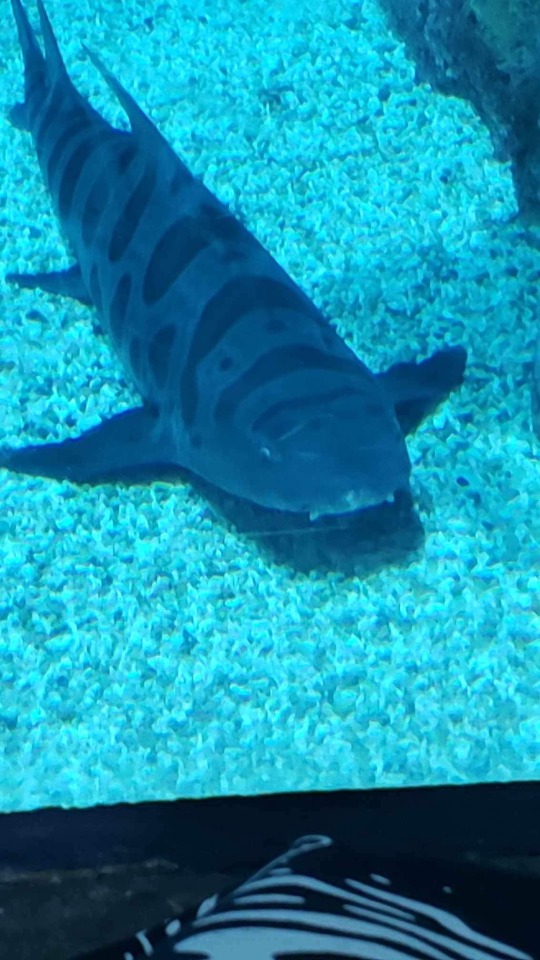
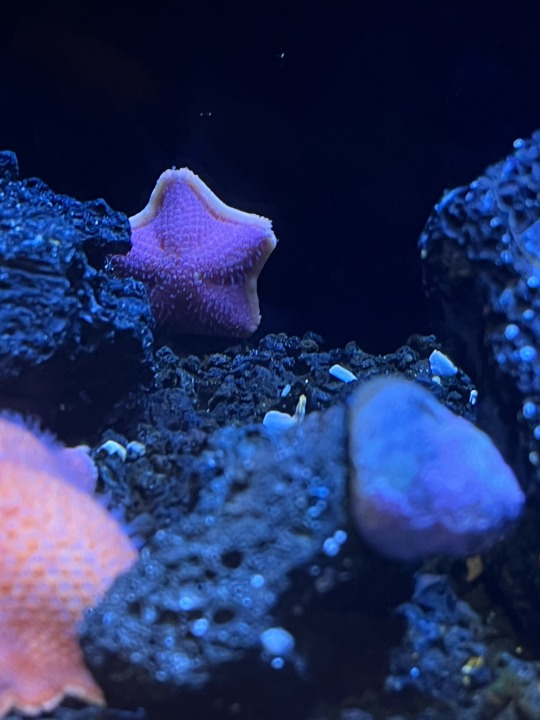

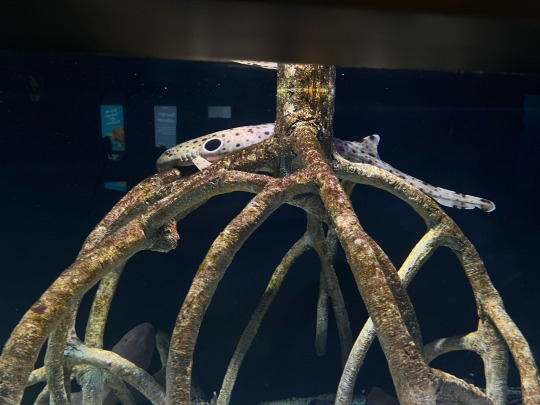


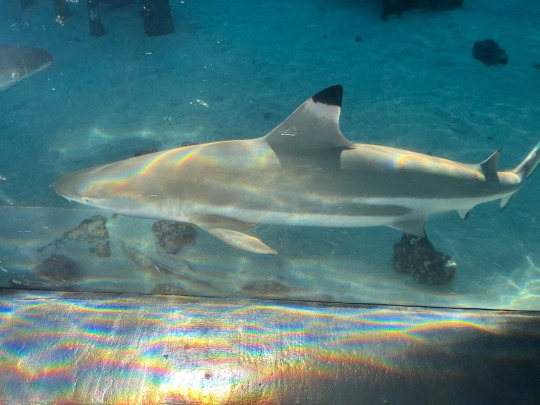
#jay speaketh#my pics#aquarium#sharks spotted I was so happy#got to see bamboo epaulette grey sandbar and blacktip reef sharks#as well as seeing both leopard AND zebra sharks#they confuse me I still need to get their differences down#sharks#fish#ocean#save the ocean#conservation
2 notes
·
View notes
Text
Bloo Lagoon
Bali Bloo Lagoon Beach is on the east side of Bali and it took us about 1.5 hours from Kuta just to drive there. But the beach was worth it – it was like a hidden paradise. Bloo Lagoon Beach is clean and water is quite sheer so it’s easy to see what’s underneath. Another good thing, there are not many people there.
Bloo Lagoon Beach located approximately one hour and a half from Denpasar International Airport, Padangbai is a busy port where most people take the ferry to/from Lombok and onwards to the Gilis, Komodo Islands and Flores. With its beautiful setting, small, unspoiled village feel, it must qualify as one of the most attractive port towns in the world. At the northern end of the town sits the eleventh century Pura Silayukti Temple and just beyond it lies the Blue Lagoon, a small white sand beach great for snorkeling, diving and relaxing in the local warungs.
Blue Lagoon Beach is close to Padangbai harbour. Known as an underwater paradise, the water is warm and the marine life is abundant. You may well see clouds of ultraviolet fish daubed with splashes of luminous orange, followed by shoals of black fish with tails shaped like the head of a spanner, you might even see a fish in a leopard-print coat, and if you look carefully, you will notice cleverly camouflaged creatures hiding in the reef crevices. The coastline borders a coral garden where you can snorkel among psychedelic fish. Padangbai is a major harbour for ferries to Lombok as well as for smaller boats to Nusa Penida. It is a very picturesque village, with semi-circular hills surrounding a sparkling blue bay. It is also home to a famous temple, Pura Silayukti, where the Buddhist sage Mpu Kuturan is said to have lived in the 11th century.
Bloo Lagoon Beach is a great beach for snorkeling. The coral reef is right up to the shore and is very pretty. Best way is to enter on the far left side, where there is a coral-less canal that leads to the snorkling site. There are two restaurants with reasonable food, showers, chairs and snorkeling gear. The beach is easily accessible. To reach Blue Lagoon Beach, head east on foot over the prominent headland at the eastern end of the main bay. Follow the signs that say Blue Lagoon. Note that wading through the water can be both frustrating and dangerous due to an abundance of coral and submerged rocks.
There is good snorkeling in the bay, though the snorkeling at the Bloo Lagoon or White Sand Beach is much better. Beware of the current and remember basic safety rules, such as never to snorkel alone and not to swim to far off in a place that you do not know.
Several small shops in the main street of Padang Bai rent snorkeling equipment. They can also organise traditional jukung boats to bring you to the best spots and greatly increase your safety. On a calm day expect lots of fish and great visibility.
Access
Just a few minutes from Padang Bai’s harbor by traditional boats or speedboats. This means Geko Divers come back to shore to enjoy a relaxed surface interval between dives. Great for socialising with your buddies or newly-met friends!
Coral Reef State:
Good variety of hard and soft corals, various types of gorgonians, healthy staghorn corals, huge coral boomies and table corals at White Sand Beach, Tanjung Sari and Blue Lagoon dive sites. Other sites like Secret Jetty or Secret Jepun are muck dive sites and have very little coral cover, but tons of critters. Great for macro lovers and photographers!
Fish Species
Hundreds of species, both large and small, can be observed in a given dive site.
Oriental sweet lips, moray eels, many species of clownfish and anemone fish, napoleon wrasses, trevalies, jackfish, dogtoothe tunas, king mackerels, crocodilefish, lionfish, octopus, pharoah cuttlefish and green turtles.
High chance of seeing sharks (whitetip, blacktip reef, nurse and wobbegong) on some of the dive sites (Tanjung Sari/Shark Point, Ferry Channel).
Macro critters: frogfish, ornate, robust and ghost pipefish, leaf scorpionfish, pygmy seahorses, nudibranches and flabelinas, siagiani squat lobsters, orang-utang crabs, zebra crabs and other rare crustaceans.
Night dives in Blue Lagoon or Tanjung Jepun also feature the appearance of many rare species of fish and crustaceans that hide during the day. Spanish dancers and juvenile leopard sharks are not uncommon.
Current
Mild to moderate (strong when new moon). Usually good conditions for beginners.
Note
Dive conditions are best early in the morning in Padang Bay. Sea can get rough in the afternoon. We recommend divers to come before 8:30AM, if they haven’t booked and want to dive on the day. Of course, it’s always best to book ahead of time!
Highlights
Whitetip reef sharks, green turtle, rich macro life and great coral reefs!
Night dives, lots of strange crabs, shrimps and lobsters and almost every night in the Blue Lagoon, we have the Spanish dancer.
Hidden Paradise Bloo Lagoon Bali
Bloo Lagoon Bali Bloo Lagoon Beach is on the east side of Bali and it took us about 1.5 hours from Kuta just to drive there.
Hidden Paradise Bloo Lagoon Bali
Bloo Lagoon Bali Bloo Lagoon Beach is on the east side of Bali and it took us about 1.5 hours from Kuta just to drive there.
Hidden Paradise Bloo Lagoon Bali
Bloo Lagoon Bali Bloo Lagoon Beach is on the east side of Bali and it took us about 1.5 hours from Kuta just to drive there.
Hidden Paradise Bloo Lagoon Bali Bloo Lagoon Bali Bloo Lagoon Beach is on the east side of Bali and it took us about 1.5 hours from Kuta just to drive there.
0 notes
Text
Bloo Lagoon
Bali Bloo Lagoon Beach is on the east side of Bali and it took us about 1.5 hours from Kuta just to drive there. But the beach was worth it – it was like a hidden paradise. Bloo Lagoon Beach is clean and water is quite sheer so it’s easy to see what’s underneath. Another good thing, there are not many people there.
Bloo Lagoon Beach located approximately one hour and a half from Denpasar International Airport, Padangbai is a busy port where most people take the ferry to/from Lombok and onwards to the Gilis, Komodo Islands and Flores. With its beautiful setting, small, unspoiled village feel, it must qualify as one of the most attractive port towns in the world. At the northern end of the town sits the eleventh century Pura Silayukti Temple and just beyond it lies the Blue Lagoon, a small white sand beach great for snorkeling, diving and relaxing in the local warungs.
Blue Lagoon Beach is close to Padangbai harbour. Known as an underwater paradise, the water is warm and the marine life is abundant. You may well see clouds of ultraviolet fish daubed with splashes of luminous orange, followed by shoals of black fish with tails shaped like the head of a spanner, you might even see a fish in a leopard-print coat, and if you look carefully, you will notice cleverly camouflaged creatures hiding in the reef crevices. The coastline borders a coral garden where you can snorkel among psychedelic fish. Padangbai is a major harbour for ferries to Lombok as well as for smaller boats to Nusa Penida. It is a very picturesque village, with semi-circular hills surrounding a sparkling blue bay. It is also home to a famous temple, Pura Silayukti, where the Buddhist sage Mpu Kuturan is said to have lived in the 11th century.
Bloo Lagoon Beach is a great beach for snorkeling. The coral reef is right up to the shore and is very pretty. Best way is to enter on the far left side, where there is a coral-less canal that leads to the snorkling site. There are two restaurants with reasonable food, showers, chairs and snorkeling gear. The beach is easily accessible. To reach Blue Lagoon Beach, head east on foot over the prominent headland at the eastern end of the main bay. Follow the signs that say Blue Lagoon. Note that wading through the water can be both frustrating and dangerous due to an abundance of coral and submerged rocks.
There is good snorkeling in the bay, though the snorkeling at the Bloo Lagoon or White Sand Beach is much better. Beware of the current and remember basic safety rules, such as never to snorkel alone and not to swim to far off in a place that you do not know.
Several small shops in the main street of Padang Bai rent snorkeling equipment. They can also organise traditional jukung boats to bring you to the best spots and greatly increase your safety. On a calm day expect lots of fish and great visibility.
Access
Just a few minutes from Padang Bai’s harbor by traditional boats or speedboats. This means Geko Divers come back to shore to enjoy a relaxed surface interval between dives. Great for socialising with your buddies or newly-met friends!
Coral Reef State:
Good variety of hard and soft corals, various types of gorgonians, healthy staghorn corals, huge coral boomies and table corals at White Sand Beach, Tanjung Sari and Blue Lagoon dive sites. Other sites like Secret Jetty or Secret Jepun are muck dive sites and have very little coral cover, but tons of critters. Great for macro lovers and photographers!
Fish Species
Hundreds of species, both large and small, can be observed in a given dive site.
Oriental sweet lips, moray eels, many species of clownfish and anemone fish, napoleon wrasses, trevalies, jackfish, dogtoothe tunas, king mackerels, crocodilefish, lionfish, octopus, pharoah cuttlefish and green turtles.
High chance of seeing sharks (whitetip, blacktip reef, nurse and wobbegong) on some of the dive sites (Tanjung Sari/Shark Point, Ferry Channel).
Macro critters: frogfish, ornate, robust and ghost pipefish, leaf scorpionfish, pygmy seahorses, nudibranches and flabelinas, siagiani squat lobsters, orang-utang crabs, zebra crabs and other rare crustaceans.
Night dives in Blue Lagoon or Tanjung Jepun also feature the appearance of many rare species of fish and crustaceans that hide during the day. Spanish dancers and juvenile leopard sharks are not uncommon.
Current
Mild to moderate (strong when new moon). Usually good conditions for beginners.
Note
Dive conditions are best early in the morning in Padang Bay. Sea can get rough in the afternoon. We recommend divers to come before 8:30AM, if they haven’t booked and want to dive on the day. Of course, it’s always best to book ahead of time!
Highlights
Whitetip reef sharks, green turtle, rich macro life and great coral reefs!
Night dives, lots of strange crabs, shrimps and lobsters and almost every night in the Blue Lagoon, we have the Spanish dancer.
Hidden Paradise Bloo Lagoon Bali
Bloo Lagoon Bali Bloo Lagoon Beach is on the east side of Bali and it took us about 1.5 hours from Kuta just to drive there.
Hidden Paradise Bloo Lagoon Bali
Bloo Lagoon Bali Bloo Lagoon Beach is on the east side of Bali and it took us about 1.5 hours from Kuta just to drive there.
Hidden Paradise Bloo Lagoon Bali Bloo Lagoon Bali Bloo Lagoon Beach is on the east side of Bali and it took us about 1.5 hours from Kuta just to drive there.
0 notes
Text
Bloo Lagoon
Bali Bloo Lagoon Beach is on the east side of Bali and it took us about 1.5 hours from Kuta just to drive there. But the beach was worth it – it was like a hidden paradise. Bloo Lagoon Beach is clean and water is quite sheer so it’s easy to see what’s underneath. Another good thing, there are not many people there.
Bloo Lagoon Beach located approximately one hour and a half from Denpasar International Airport, Padangbai is a busy port where most people take the ferry to/from Lombok and onwards to the Gilis, Komodo Islands and Flores. With its beautiful setting, small, unspoiled village feel, it must qualify as one of the most attractive port towns in the world. At the northern end of the town sits the eleventh century Pura Silayukti Temple and just beyond it lies the Blue Lagoon, a small white sand beach great for snorkeling, diving and relaxing in the local warungs.
Blue Lagoon Beach is close to Padangbai harbour. Known as an underwater paradise, the water is warm and the marine life is abundant. You may well see clouds of ultraviolet fish daubed with splashes of luminous orange, followed by shoals of black fish with tails shaped like the head of a spanner, you might even see a fish in a leopard-print coat, and if you look carefully, you will notice cleverly camouflaged creatures hiding in the reef crevices. The coastline borders a coral garden where you can snorkel among psychedelic fish. Padangbai is a major harbour for ferries to Lombok as well as for smaller boats to Nusa Penida. It is a very picturesque village, with semi-circular hills surrounding a sparkling blue bay. It is also home to a famous temple, Pura Silayukti, where the Buddhist sage Mpu Kuturan is said to have lived in the 11th century.
Bloo Lagoon Beach is a great beach for snorkeling. The coral reef is right up to the shore and is very pretty. Best way is to enter on the far left side, where there is a coral-less canal that leads to the snorkling site. There are two restaurants with reasonable food, showers, chairs and snorkeling gear. The beach is easily accessible. To reach Blue Lagoon Beach, head east on foot over the prominent headland at the eastern end of the main bay. Follow the signs that say Blue Lagoon. Note that wading through the water can be both frustrating and dangerous due to an abundance of coral and submerged rocks.
There is good snorkeling in the bay, though the snorkeling at the Bloo Lagoon or White Sand Beach is much better. Beware of the current and remember basic safety rules, such as never to snorkel alone and not to swim to far off in a place that you do not know.
Several small shops in the main street of Padang Bai rent snorkeling equipment. They can also organise traditional jukung boats to bring you to the best spots and greatly increase your safety. On a calm day expect lots of fish and great visibility.
Access
Just a few minutes from Padang Bai’s harbor by traditional boats or speedboats. This means Geko Divers come back to shore to enjoy a relaxed surface interval between dives. Great for socialising with your buddies or newly-met friends!
Coral Reef State:
Good variety of hard and soft corals, various types of gorgonians, healthy staghorn corals, huge coral boomies and table corals at White Sand Beach, Tanjung Sari and Blue Lagoon dive sites. Other sites like Secret Jetty or Secret Jepun are muck dive sites and have very little coral cover, but tons of critters. Great for macro lovers and photographers!
Fish Species
Hundreds of species, both large and small, can be observed in a given dive site.
Oriental sweet lips, moray eels, many species of clownfish and anemone fish, napoleon wrasses, trevalies, jackfish, dogtoothe tunas, king mackerels, crocodilefish, lionfish, octopus, pharoah cuttlefish and green turtles.
High chance of seeing sharks (whitetip, blacktip reef, nurse and wobbegong) on some of the dive sites (Tanjung Sari/Shark Point, Ferry Channel).
Macro critters: frogfish, ornate, robust and ghost pipefish, leaf scorpionfish, pygmy seahorses, nudibranches and flabelinas, siagiani squat lobsters, orang-utang crabs, zebra crabs and other rare crustaceans.
Night dives in Blue Lagoon or Tanjung Jepun also feature the appearance of many rare species of fish and crustaceans that hide during the day. Spanish dancers and juvenile leopard sharks are not uncommon.
Current
Mild to moderate (strong when new moon). Usually good conditions for beginners.
Note
Dive conditions are best early in the morning in Padang Bay. Sea can get rough in the afternoon. We recommend divers to come before 8:30AM, if they haven’t booked and want to dive on the day. Of course, it’s always best to book ahead of time!
Highlights
Whitetip reef sharks, green turtle, rich macro life and great coral reefs!
Night dives, lots of strange crabs, shrimps and lobsters and almost every night in the Blue Lagoon, we have the Spanish dancer.
Hidden Paradise Bloo Lagoon Bali
Bloo Lagoon Bali Bloo Lagoon Beach is on the east side of Bali and it took us about 1.5 hours from Kuta just to drive there.
Hidden Paradise Bloo Lagoon Bali Bloo Lagoon Bali Bloo Lagoon Beach is on the east side of Bali and it took us about 1.5 hours from Kuta just to drive there.
0 notes
Text
Kenya's unmissable experiences

Overview
Despite having a coastline of beautiful beaches perfect for lazing. Kenya rarely inspires visitors to sit still – there are simply too many exciting things to experience. Stirring landscapes, ranging from equatorial glaciers and jagged peaks to wildlife-laden. Plains and tropical reefs, provide an epic natural playground for all who venture here, while the many intoxicating cultures surprise at each and every turn.
Big Five safaris
Not only were safaris born in Kenya, but so was the very word itself – it means ‘journey’ in Swahili. Spotting the much-heralded Big Five (lion, leopard, buffalo, rhino and elephant) is a major aspiration of many visitors to Africa, and as one would suspect, Kenya provides some of the continent’s most impressive natural venues for it. None of which is more famous than the Masai Mara, where sightings of all these species is common. Lake Nakuru National Park, with its flamingo-lined lake and forest-clad escarpments, is another incredible place for. Big Five safaris, as is Amboseli National Park, where Mt Kilimanjaro provides a staggering backdrop. Samburu Game Reserve in the remote north is prime safari territory too, and also. Hosts its own ‘Samburu Big Five’: Beisa onyx, Grevy’s zebra, long-necked gerenuk, reticulated giraffe and Somali ostrich.
Lake Nakuru National Park
4-Day Maasai Mara Game-Lake Nakuru Park Safari
2 Day – Lake Nakuru & Naivasha
Hiking
Mt Kenya’s trekking terrain is arguably the continent’s most beautiful and rewarding. Its diverse valleys, equatorial glaciers and dramatic, towering summit are extraordinary sights, and best seen over a challenging multi-day hike to. Point Lenana (4985m), the mountain’s third-highest peak (and highest reachable without climbing equipment). The more gentle slopes of Mt Elgon, which are home to elephants, primates, antelopes and some 240 species of birds, are another great option for treks lasting several days, as are captivating walks with the Maasai through their homelands. Incredible day hikes are also possible throughout the country: climb up Mt Longonot to its crater rim; seek out remote waterfalls in the mountains of Aberdare National Park; or take a more leisurely stroll within the dense Kagamega Forest while listening to birdsong.
4-Day Lake Naivasha-Lake Nakuru/Maasai Mara Game Reserve
The Great Migration
It’s been called the greatest natural spectacle on the planet, and for good reason – each year from July to October,.Hundreds of thousands of wildebeest and zebra make a dramatic crossing of the crocodile-infested Mara River to feed on the lush grasses of the Masai Mara. The flood of animals filling the open savannah includes herds of elephants and giraffes, and trailing this sea of prey are lions, leopards, cheetahs and hyenas. Needless to say, there is never a shortage of drama during the great migration.
Mountain biking
Mountain biking is not just mountain biking in Kenya – here this two-wheeled pursuit offers. A unique means of embracing both the country’s incredible landscapes and its iconic wildlife. Ride over the red earth paths in the volcanic confines of Hell’s Gate National Park, cycling past grazing buffaloes, giraffes. Impalas and zebras, or take to the grasslands of the Masai Mara for a cycle safari like no other – the sense of engagement with the wildlife is amplified to no end when in the saddle. Of course, for the purest mountain bikers who want nothing more than to test their skills, there are some great single track routes of varying gradient and difficulty on Mt Kenya and within the Rift Valley above Naivasha. For those wanting a more leisurely cycle, exploring the coastal areas around Diani Beach, Malindi and Watamu by bike is an engaging option too.
Cultural encounters
Although it is dreams of Kenya’s wondrous wildlife that draws most people to this East African nation. Many people’s lasting memories revolve around their interactions with Kenyans themselves. The Maasai people, with their traditional red shukas, brilliant smiles and overwhelming presence, add a depth of warmth to any trip into the Mara region.
The same can be said for the striking Turkana people in Loyangalani along the eastern shore of the Jade Sea (Lake Turkana). Visitors to the Marsabit-Lake Turkana Festival in early. May also meet many of the other enigmatic and colourful tribes from the Kenya’s remote north, such as the El Molo, Rendille, Samburu, Dassanatch, Gabra, Borana, Konso, Sakuye, Garee, Waata, Burji and Somali. The diversity of cultures in Kenya is truly astounding. While the Swahili people on the coast differ in that they don’t share a common heritage. They are bound by a language and an African history that is tied to Arabia and Persia – there is no better place to immerse yourself in this world than in the labyrinth of crooked alleyways in Lamu.
Dhow trips
Kenya’s Indian Ocean coast is beautiful no matter how you look at it. But there is no more romantic way to experience it than from the deck of a traditional dhow. These wooden sailing vessels have been used along this stretch of coastline for centuries, and they are still entrenched in the Swahili culture today. Whether launching from the historical island of. Lamu (home to Kenya’s oldest continually inhabited town) or the modern resort village of Diani Beach, these wind-powered voyages will slip past stunning slivers of sand. Remote coral islands and reefs teeming with fish.
Water sports
Want a burst of adrenaline with your taste of the Indian Ocean? The same winds that power the elegant dhows fuels two great water sports: windsurfing and kitesurfing (also known as kiteboarding). The latter has caught on massively in Kenya, with many schools now providing lessons for beginners as well as equipment rentals for people with experience. Diani Beach is the epicentre of action, though the waters off Watamu are also highly recommended. The fun doesn’t stop inland, however, with whitewater rafting trips possible on both the Tana and Athi rivers, which thunder down from the Central Highlands at certain points during the year.
Hot air ballooning
Perhaps the most intoxicating safari experience in Kenya is to slowly climb. One exciting flame blast at a time – above the famous rolling savannah and flat-topped acacia trees of the Masai Mara in a hot air balloon. Floating silently over streams of wildebeest on their great migration. Lions stalking their prey or a lone black rhino moving through the bush is a perspective that nobody can ever forget. When the light is just right it’s possible to marvel at the perfectly proportioned. Elephant-shaped shadows cast by the largest member of the Big Five. Few experiences in life are as peaceful as they are exciting, and a balloon safari here is certainly one of them.
3 Day – Amboseli Wildlife Safari
Diving and snorkelling
With much of the coast sheltered by reefs, Kenya’s calm inshore waters – speckled with shoals of vibrantly coloured fish. Provide some of the easiest and most transfixing snorkelling in East Africa. Simply float above the seabed five metres below and take it all in. Or strap on a tank and take a deeper dip on the other side of the reef, where whale sharks, dolphins and swordfish play. For those wanting to up their diving skills there are some highly regarded operations that offer open water diving courses. For beginners, Kenya is also a great place to get your toes wet – there are schools in Diani Beach. Malindi and Wasini Island that teach .PADI (Professional Association of Diving Instructors) courses, which start in shore-based pools beneath swaying palms.
Camel safaris
These unique safaris are a wonderful way of mixing wildlife, culture, landscapes and adventure by getting into remote areas. Where few others (and often no vehicles) go. Most operate in the northern tribal areas of the Samburu and Turkana. Which means visitors will also witness nomadic life and mingle with local people. Wildlife is not as prolific as in the southern parks, but on these trips it does not matter – the journey is the main attraction. Mornings are spent on the move, with visitors either riding the camels or walking alongside them (whichever they prefer). After striking camp around noon, participants have the rest of the day to enjoy guided walks and cultural interactions or to just relax. Experienced Samburu moran (warriors) usually lead the caravans. With English-speaking tribal guides on hand to dispense interesting details on local folklore, botany, ornithology and local customs.
See also:Amboseli National Park Destination Guide, Wildebeest Migration Masai Mara, Masai mara National Reserve and Conservancies, The Top Safaris in KenyaTop Weekend Getaway Deals in Kenya
If you think you have to travel far to enjoy a nice weekend, you may never get away. Besides, you can enjoy a beautiful weekend right here in Kenya. There are countless wallet-friendly Kenyan weekend getaways that won’t even break your budget. Don’t spend your weekend, doing absolutely nothing at home. Whether you are looking for romantic destinations, pristine beaches, and adventurous outdoor activities, there are plenty wallet-friendly getaways that will satisfy your weekend desires.
Mombasa South Coast Self Drive Deals
Lake Nakuru & Elementaita Self Drive Deals
Lukenya & Machakos Self Drive
Amboseli and Tsavo Holiday Self Drive Deals
Mt. Kenya & Aberdare Self Drive Holiday Deals
Mombasa North Coast Self Drive Deals
Samburu Holiday Self Drive Deals
Masai Mara Self Drive Holiday Packages
Malindi & Watamu Self Drive Deals
Nyahururu & Laikipia Holiday Self Drive Deals
Top Madaraka Express SGR Holiday Deals
2 Nights Malindi & Watamu holiday with SGR
2 Nights Amboseli Holiday With SGR
2 Nights Tsavo Holiday With SGR Sa
2 Nights Voi Holiday With SGR
2 Nights Mombasa North Coast With SGR
2 Nights Mombasa South Coast With SGR
Read the full article
0 notes
Text
Bloo Lagoon
Bali Bloo Lagoon Beach is on the east side of Bali and it took us about 1.5 hours from Kuta just to drive there. But the beach was worth it – it was like a hidden paradise. Bloo Lagoon Beach is clean and water is quite sheer so it’s easy to see what’s underneath. Another good thing, there are not many people there.
Bloo Lagoon Beach located approximately one hour and a half from Denpasar International Airport, Padangbai is a busy port where most people take the ferry to/from Lombok and onwards to the Gilis, Komodo Islands and Flores. With its beautiful setting, small, unspoiled village feel, it must qualify as one of the most attractive port towns in the world. At the northern end of the town sits the eleventh century Pura Silayukti Temple and just beyond it lies the Blue Lagoon, a small white sand beach great for snorkeling, diving and relaxing in the local warungs.
Blue Lagoon Beach is close to Padangbai harbour. Known as an underwater paradise, the water is warm and the marine life is abundant. You may well see clouds of ultraviolet fish daubed with splashes of luminous orange, followed by shoals of black fish with tails shaped like the head of a spanner, you might even see a fish in a leopard-print coat, and if you look carefully, you will notice cleverly camouflaged creatures hiding in the reef crevices. The coastline borders a coral garden where you can snorkel among psychedelic fish. Padangbai is a major harbour for ferries to Lombok as well as for smaller boats to Nusa Penida. It is a very picturesque village, with semi-circular hills surrounding a sparkling blue bay. It is also home to a famous temple, Pura Silayukti, where the Buddhist sage Mpu Kuturan is said to have lived in the 11th century.
Bloo Lagoon Beach is a great beach for snorkeling. The coral reef is right up to the shore and is very pretty. Best way is to enter on the far left side, where there is a coral-less canal that leads to the snorkling site. There are two restaurants with reasonable food, showers, chairs and snorkeling gear. The beach is easily accessible. To reach Blue Lagoon Beach, head east on foot over the prominent headland at the eastern end of the main bay. Follow the signs that say Blue Lagoon. Note that wading through the water can be both frustrating and dangerous due to an abundance of coral and submerged rocks.
There is good snorkeling in the bay, though the snorkeling at the Bloo Lagoon or White Sand Beach is much better. Beware of the current and remember basic safety rules, such as never to snorkel alone and not to swim to far off in a place that you do not know.
Several small shops in the main street of Padang Bai rent snorkeling equipment. They can also organise traditional jukung boats to bring you to the best spots and greatly increase your safety. On a calm day expect lots of fish and great visibility.
Access
Just a few minutes from Padang Bai’s harbor by traditional boats or speedboats. This means Geko Divers come back to shore to enjoy a relaxed surface interval between dives. Great for socialising with your buddies or newly-met friends!
Coral Reef State:
Good variety of hard and soft corals, various types of gorgonians, healthy staghorn corals, huge coral boomies and table corals at White Sand Beach, Tanjung Sari and Blue Lagoon dive sites. Other sites like Secret Jetty or Secret Jepun are muck dive sites and have very little coral cover, but tons of critters. Great for macro lovers and photographers!
Fish Species
Hundreds of species, both large and small, can be observed in a given dive site.
Oriental sweet lips, moray eels, many species of clownfish and anemone fish, napoleon wrasses, trevalies, jackfish, dogtoothe tunas, king mackerels, crocodilefish, lionfish, octopus, pharoah cuttlefish and green turtles.
High chance of seeing sharks (whitetip, blacktip reef, nurse and wobbegong) on some of the dive sites (Tanjung Sari/Shark Point, Ferry Channel).
Macro critters: frogfish, ornate, robust and ghost pipefish, leaf scorpionfish, pygmy seahorses, nudibranches and flabelinas, siagiani squat lobsters, orang-utang crabs, zebra crabs and other rare crustaceans.
Night dives in Blue Lagoon or Tanjung Jepun also feature the appearance of many rare species of fish and crustaceans that hide during the day. Spanish dancers and juvenile leopard sharks are not uncommon.
Current
Mild to moderate (strong when new moon). Usually good conditions for beginners.
Note
Dive conditions are best early in the morning in Padang Bay. Sea can get rough in the afternoon. We recommend divers to come before 8:30AM, if they haven’t booked and want to dive on the day. Of course, it’s always best to book ahead of time!
Highlights
Whitetip reef sharks, green turtle, rich macro life and great coral reefs!
Night dives, lots of strange crabs, shrimps and lobsters and almost every night in the Blue Lagoon, we have the Spanish dancer.
Hidden Paradise Bloo Lagoon Bali Bloo Lagoon Bali Bloo Lagoon Beach is on the east side of Bali and it took us about 1.5 hours from Kuta just to drive there.
0 notes